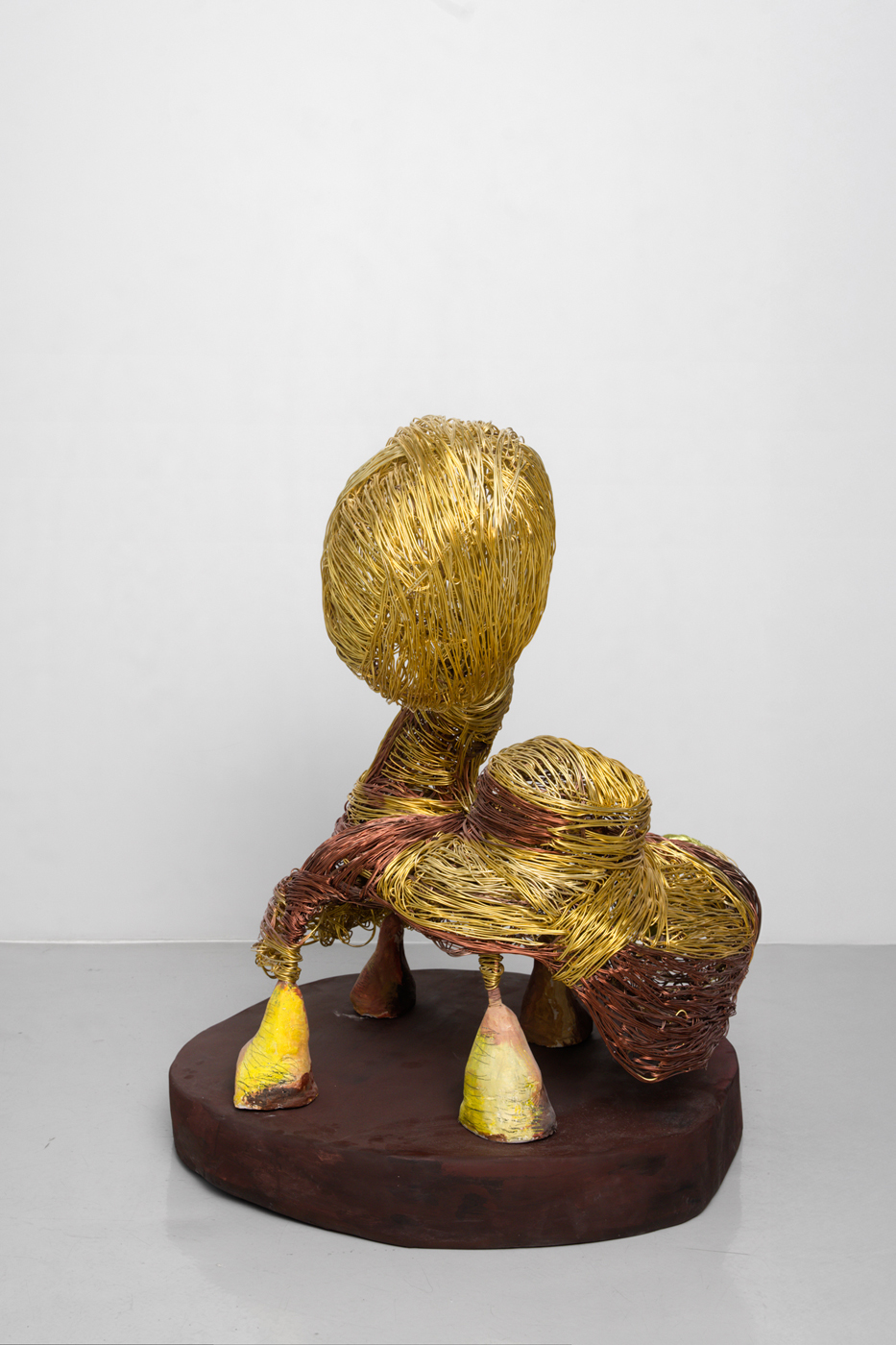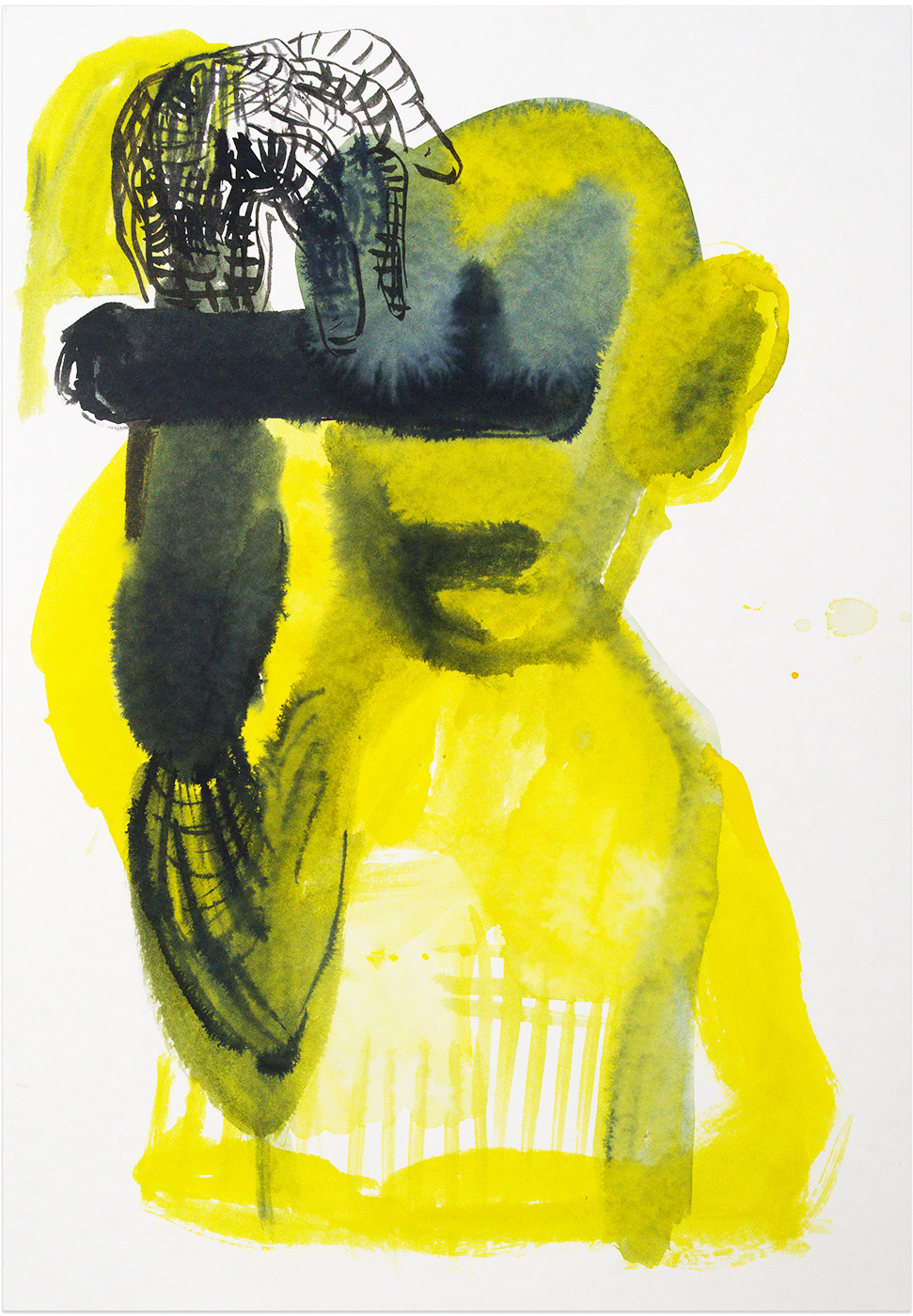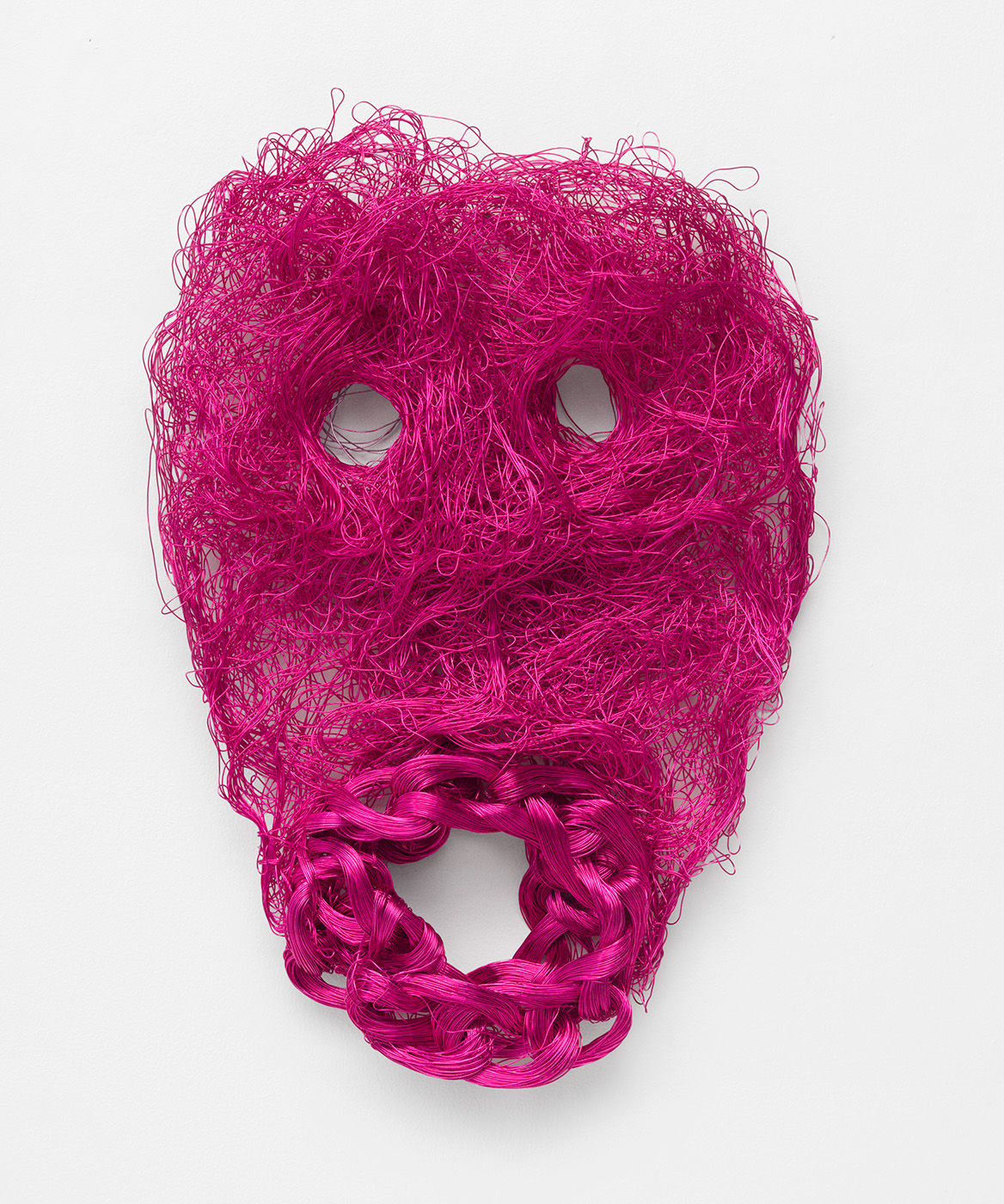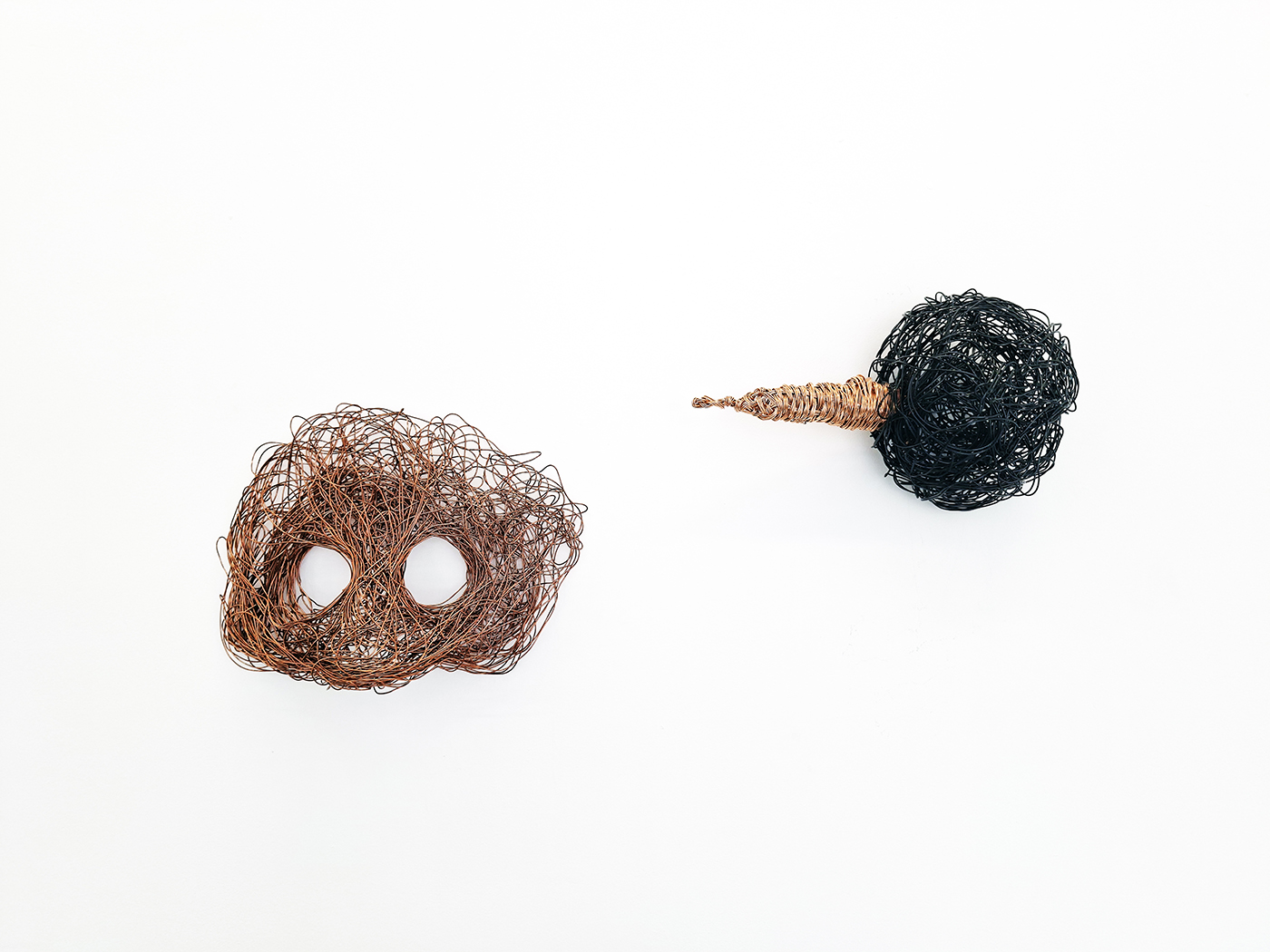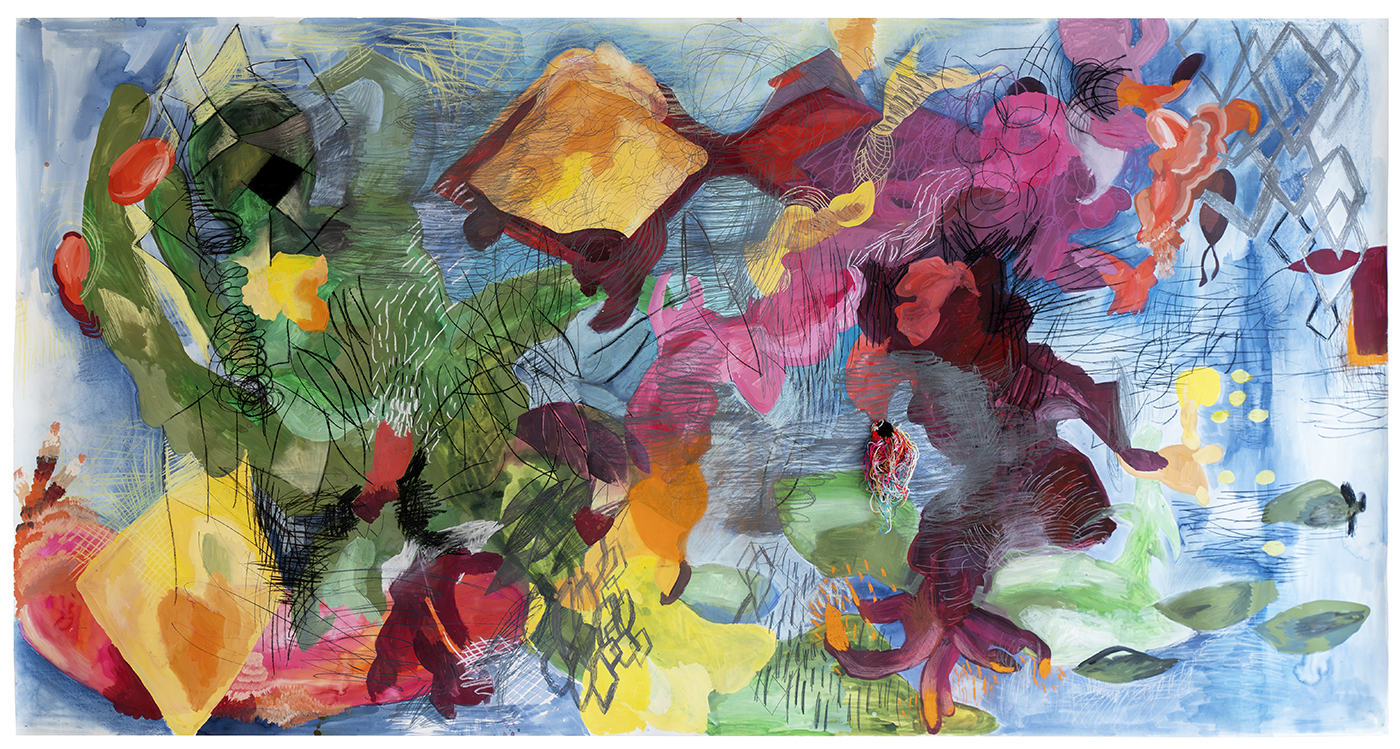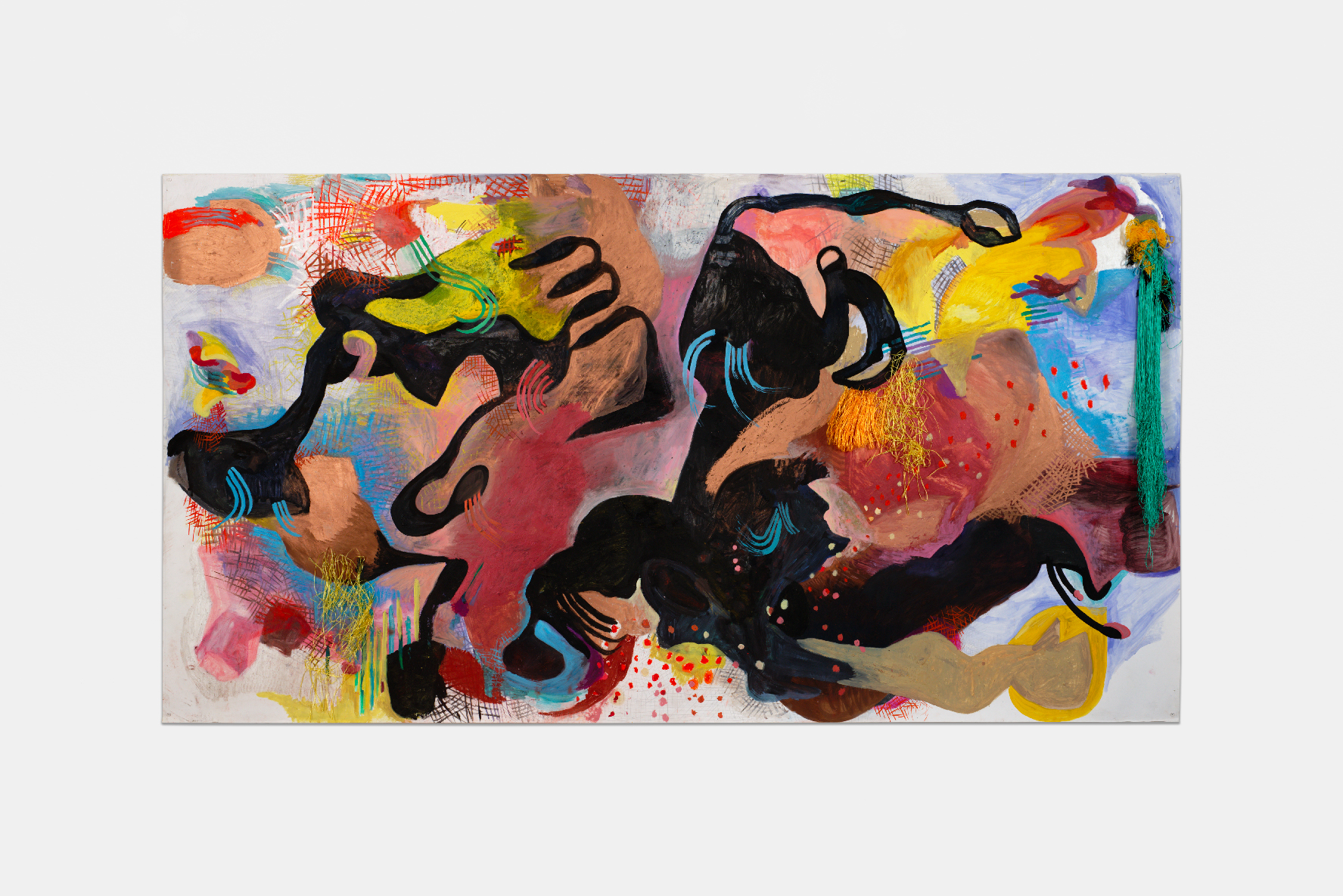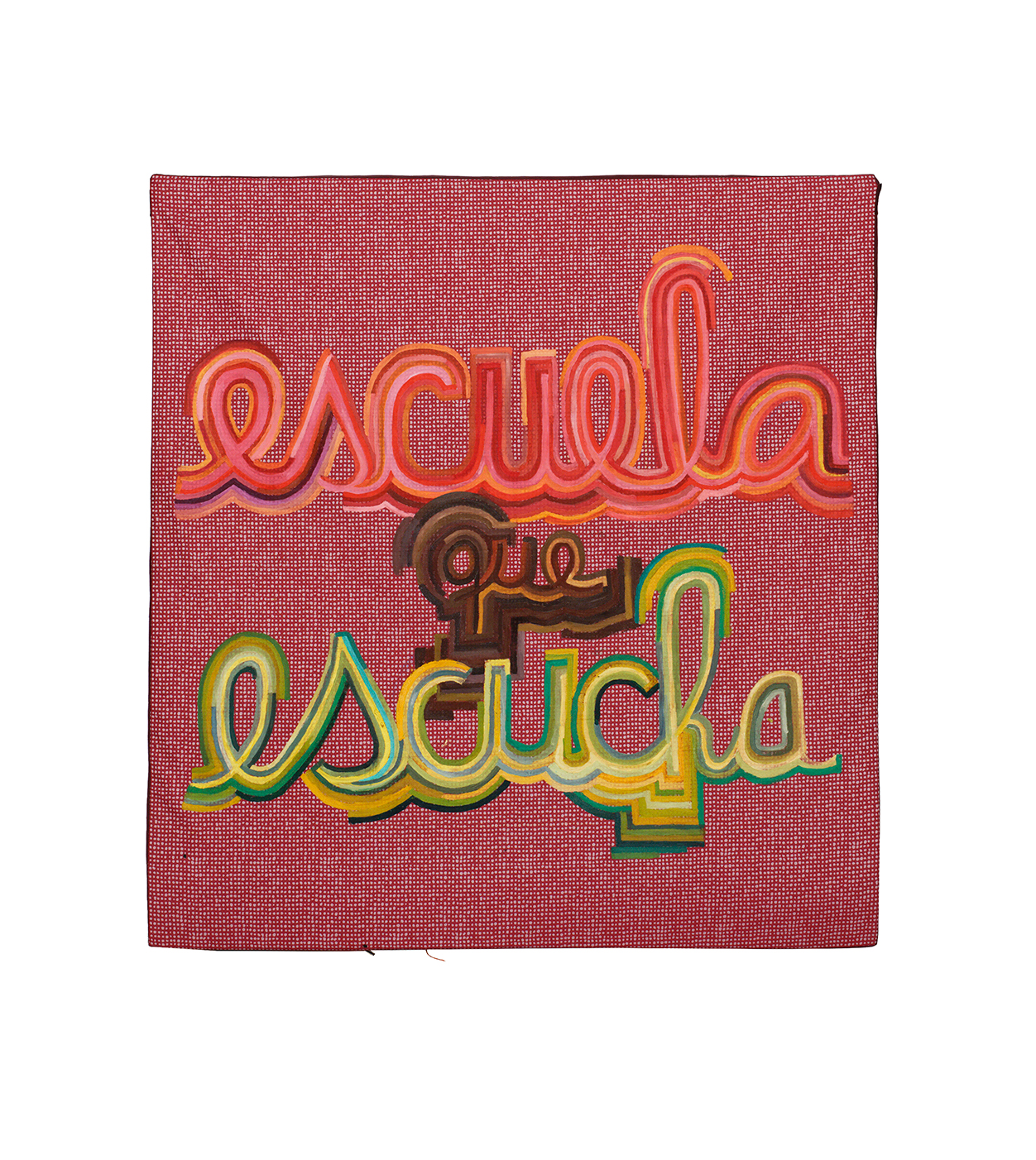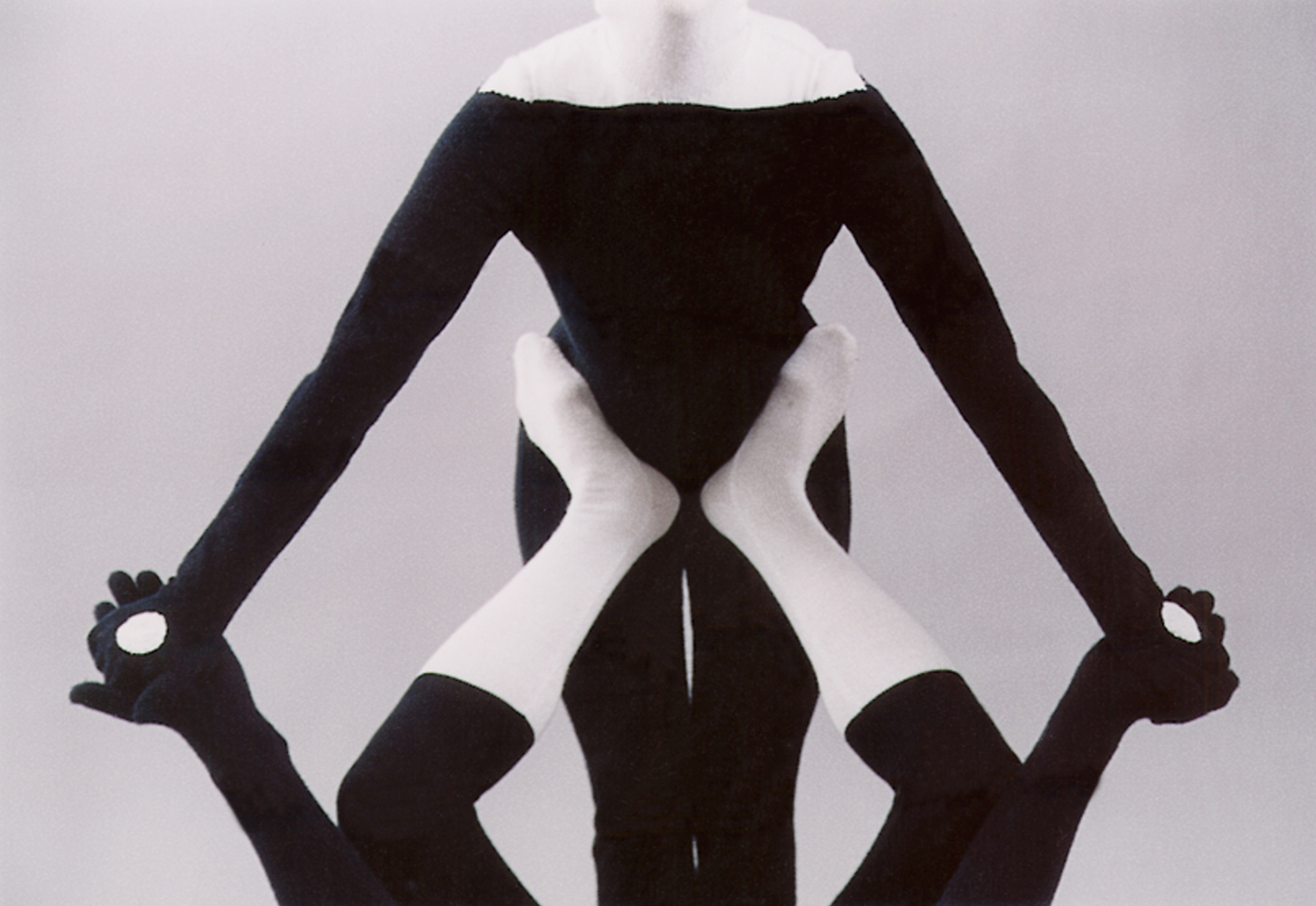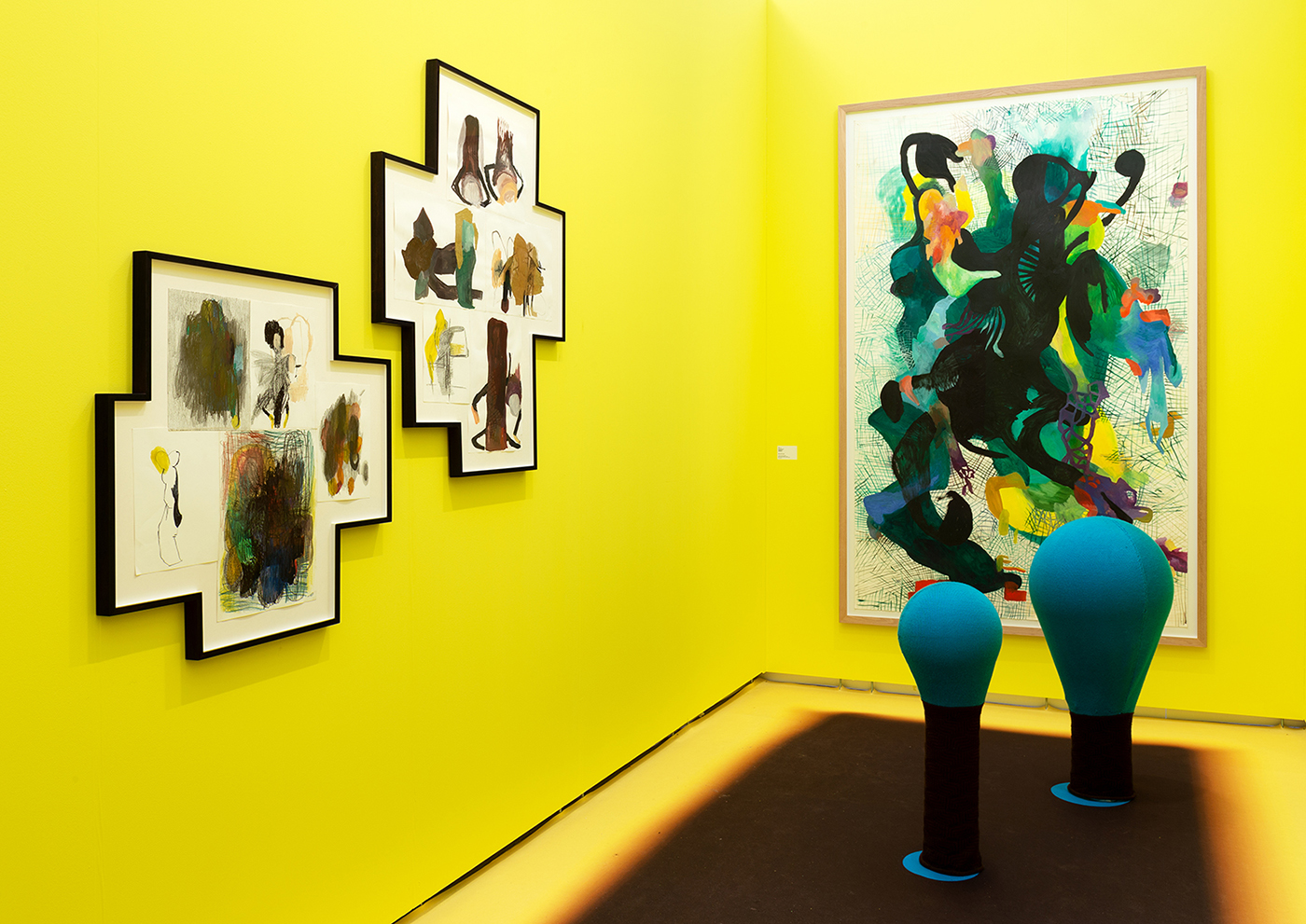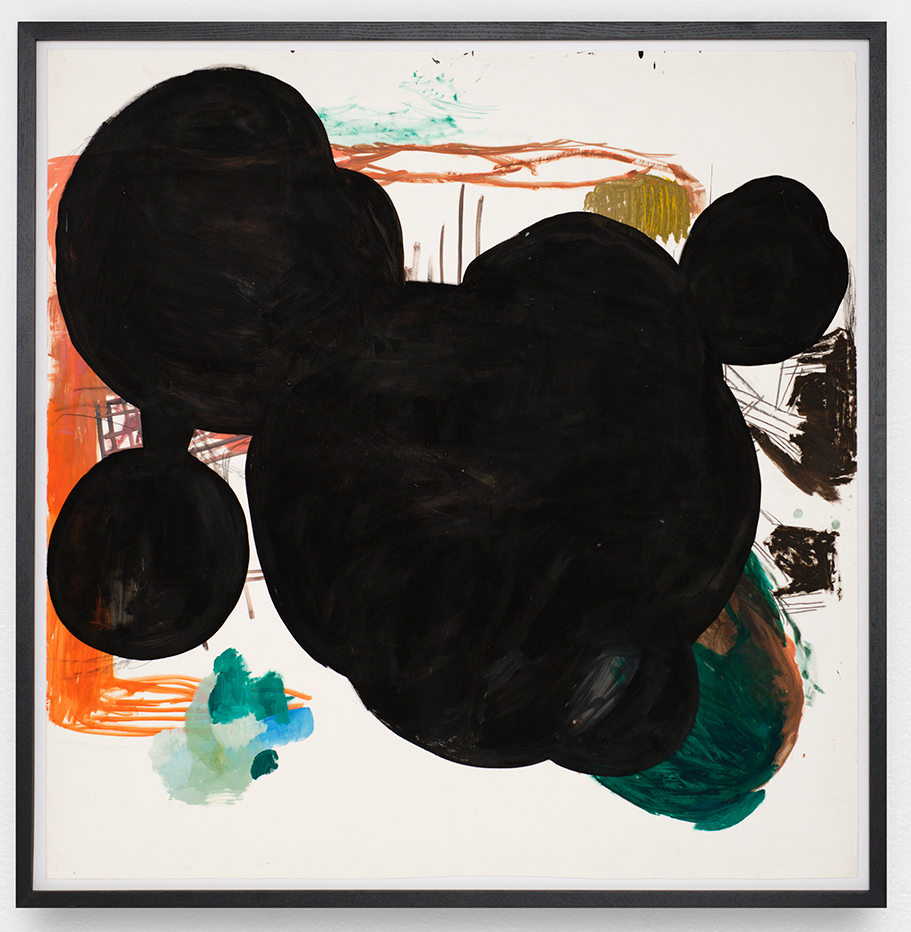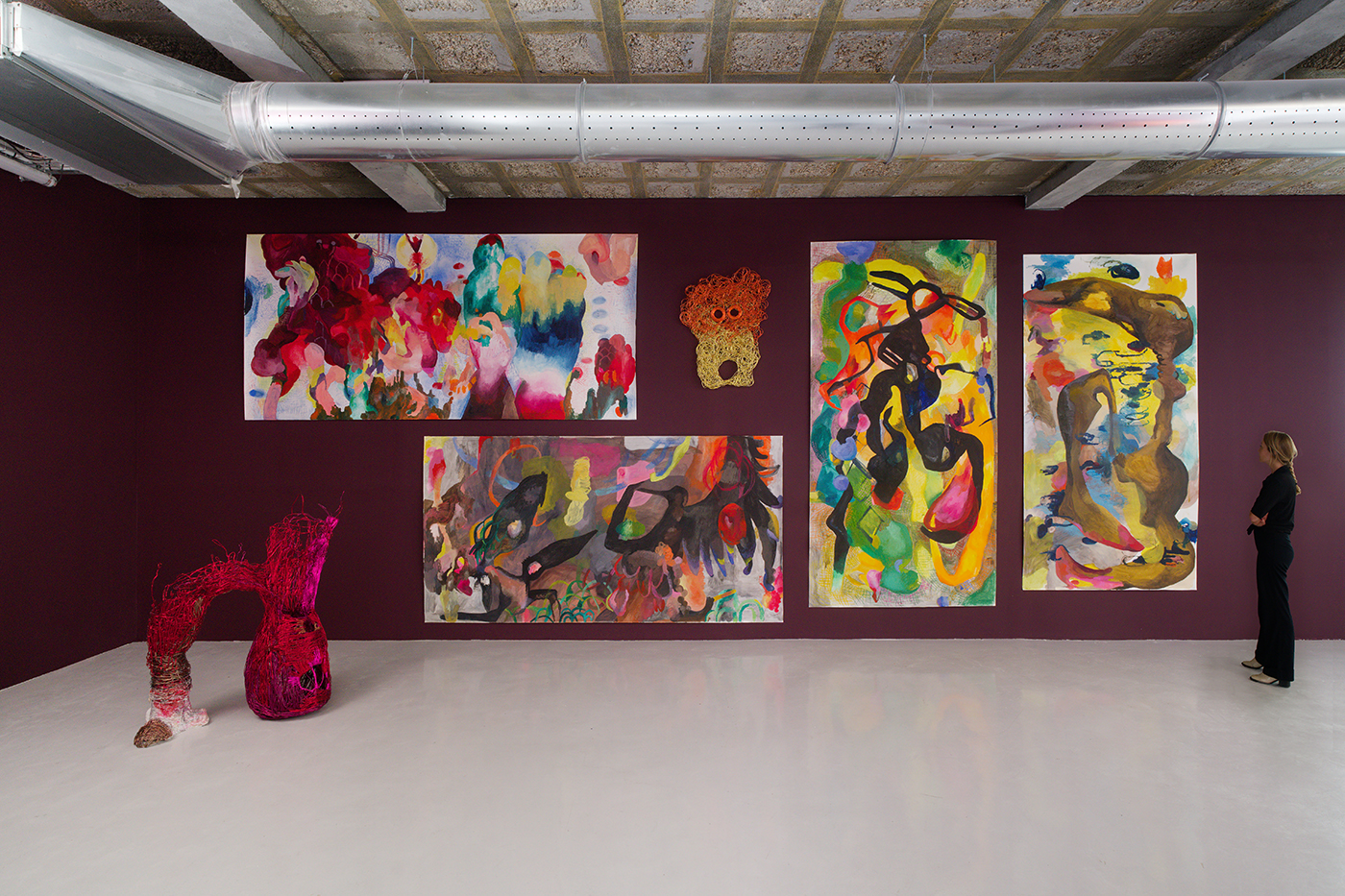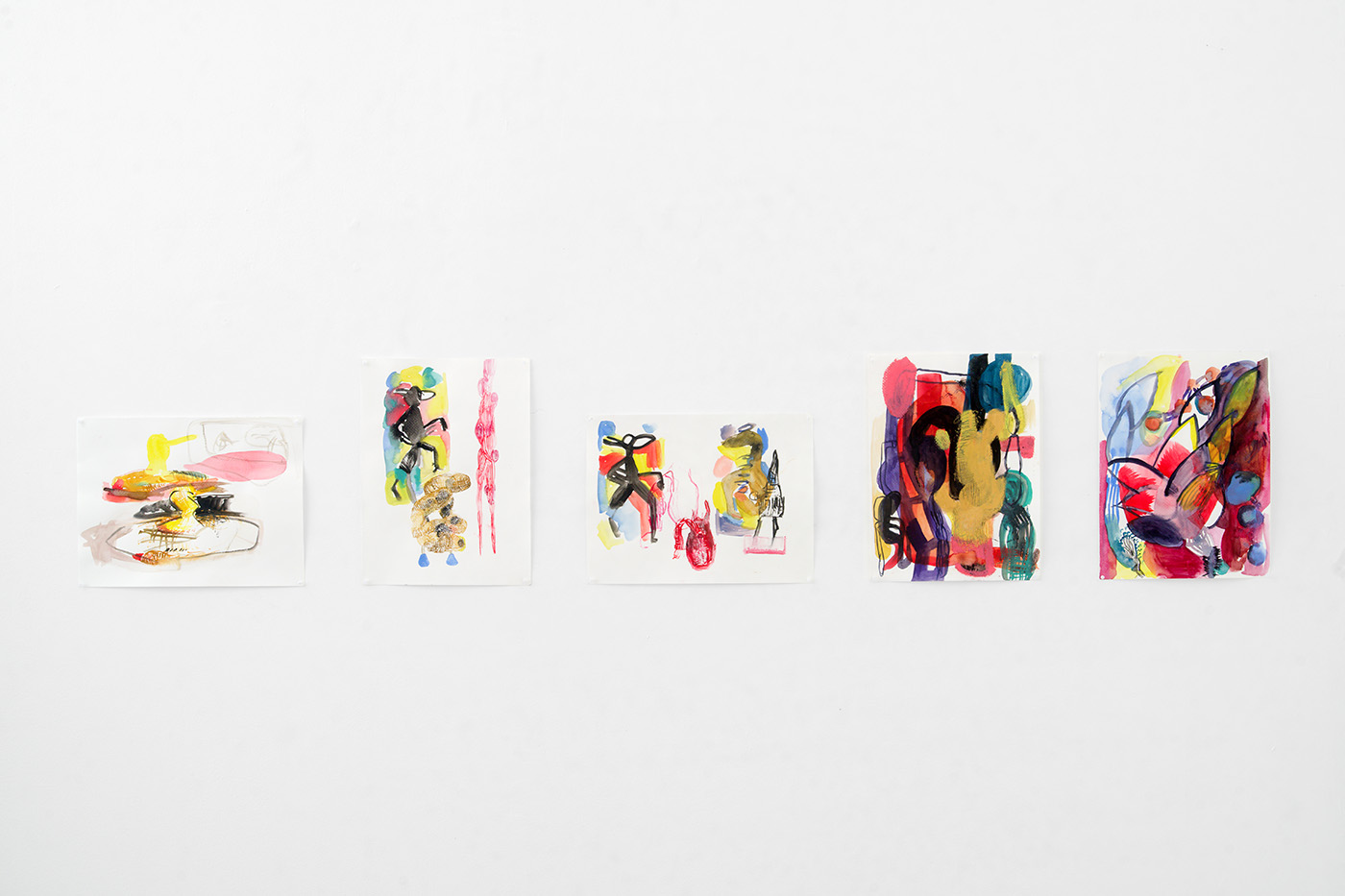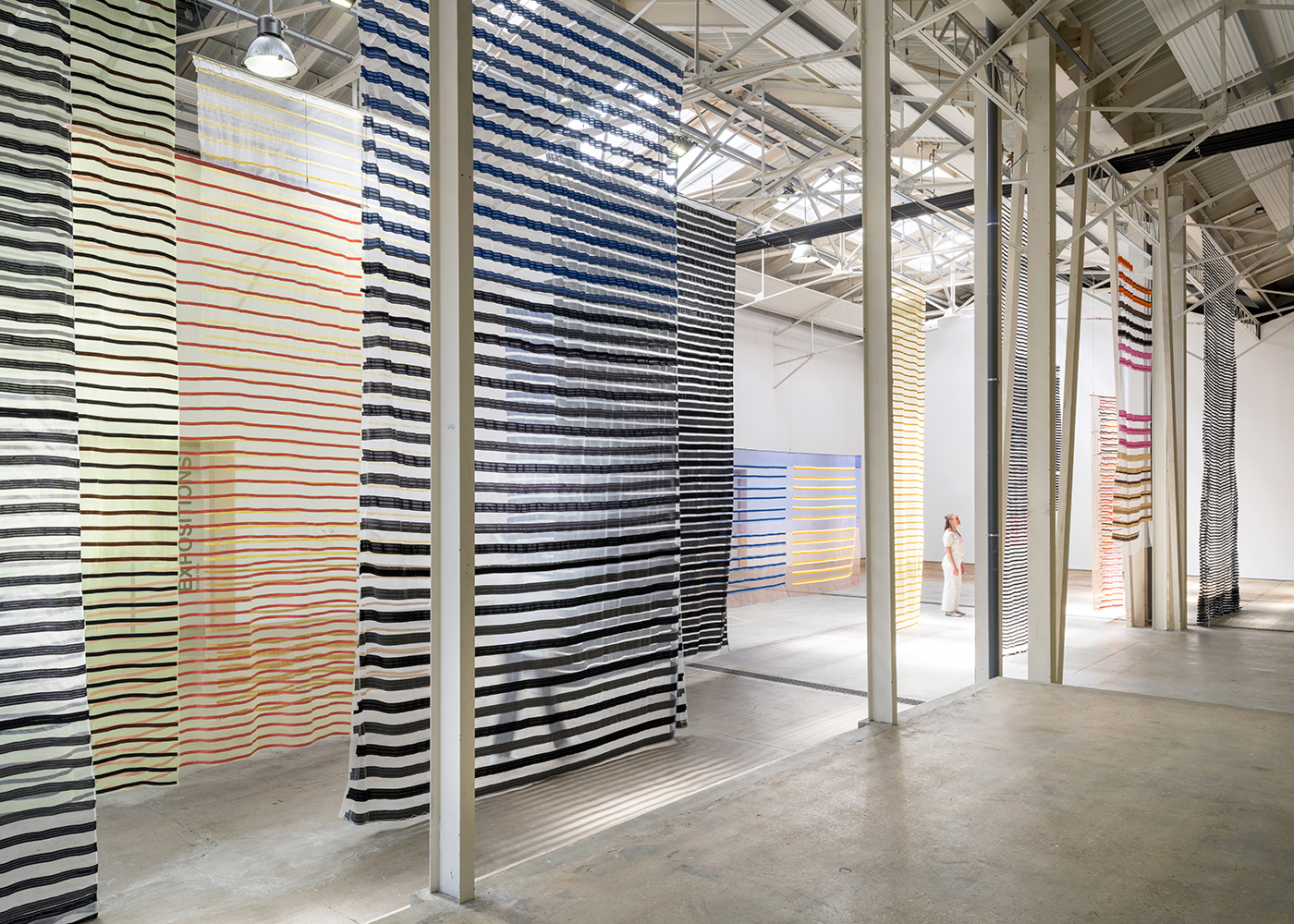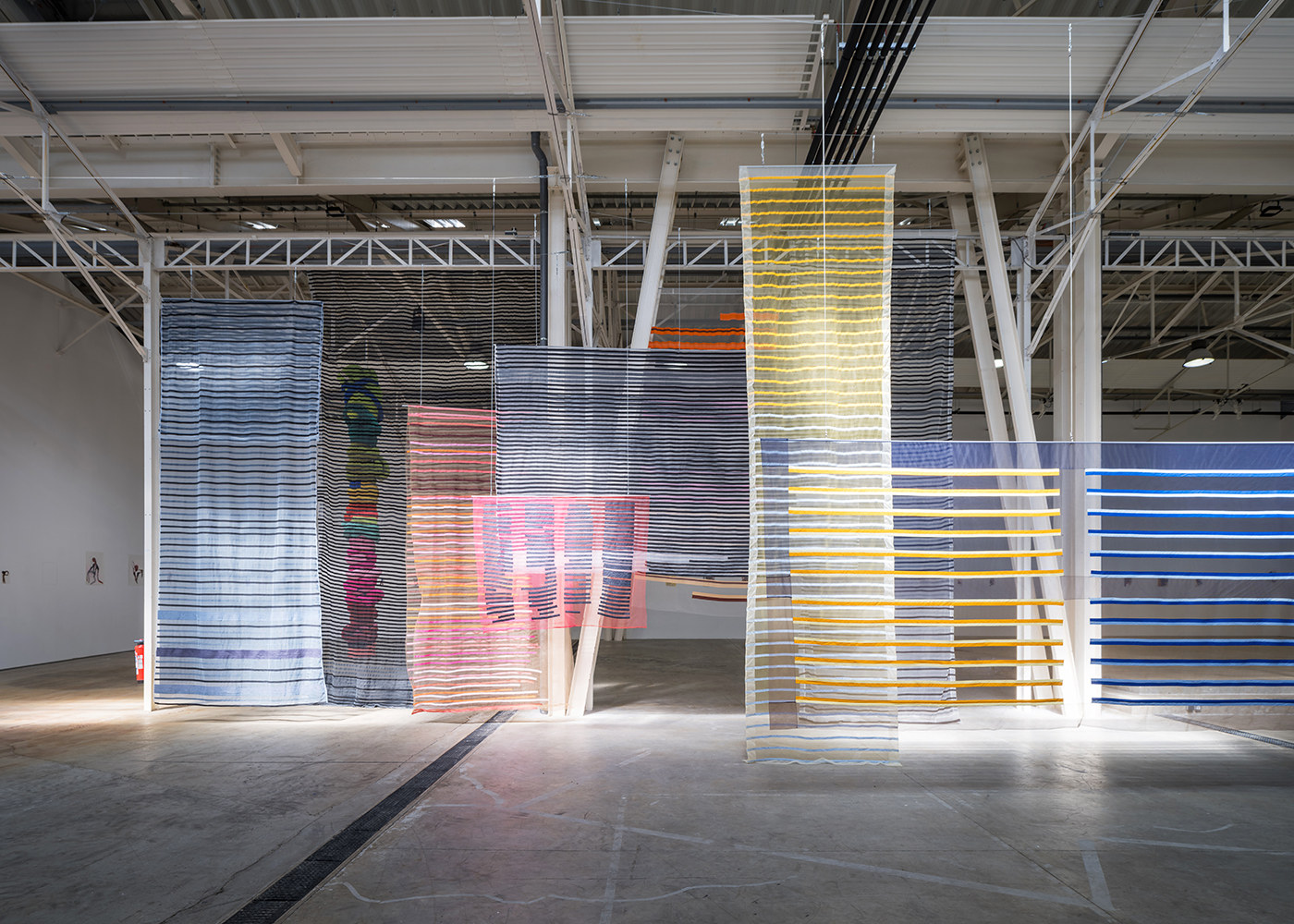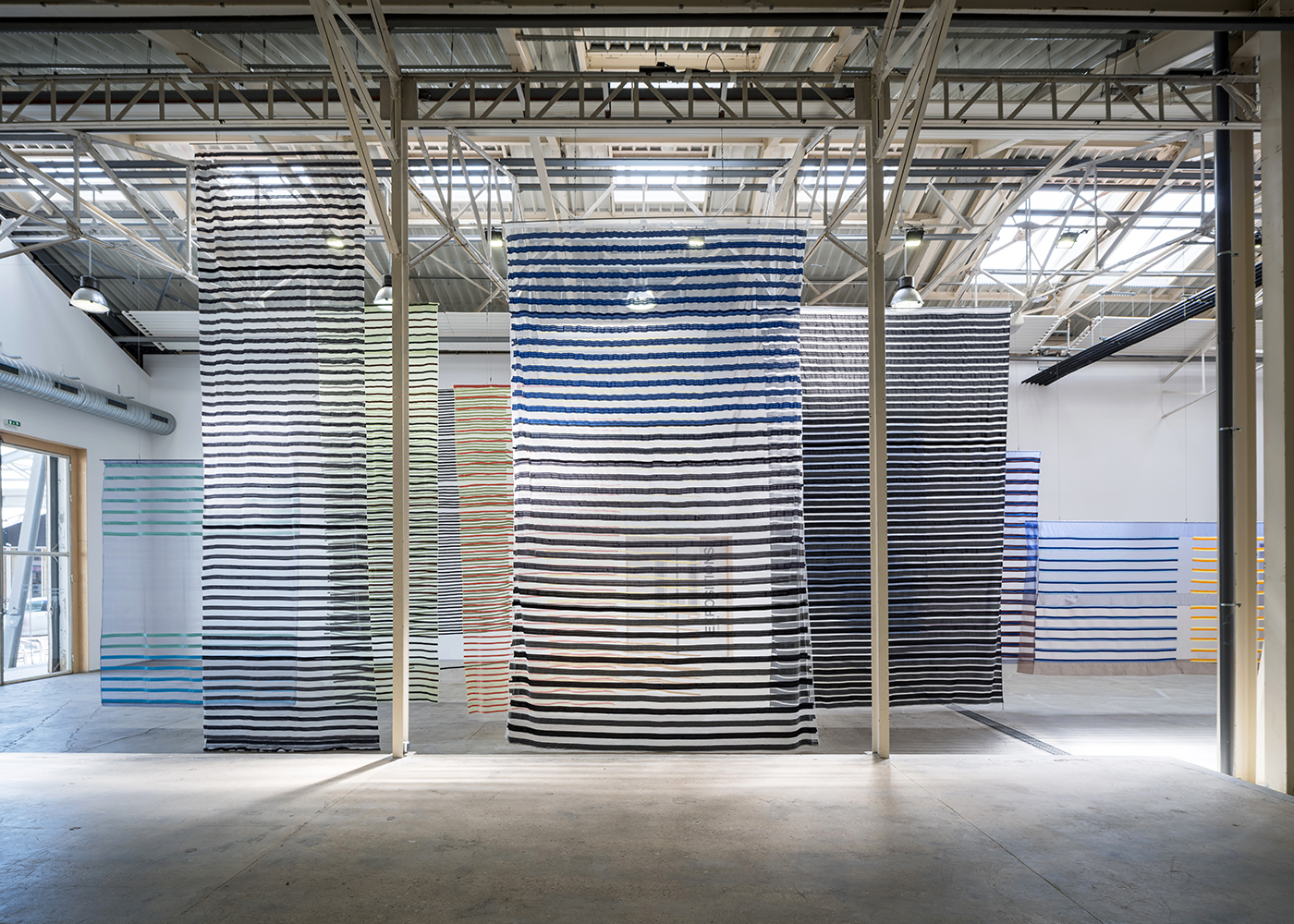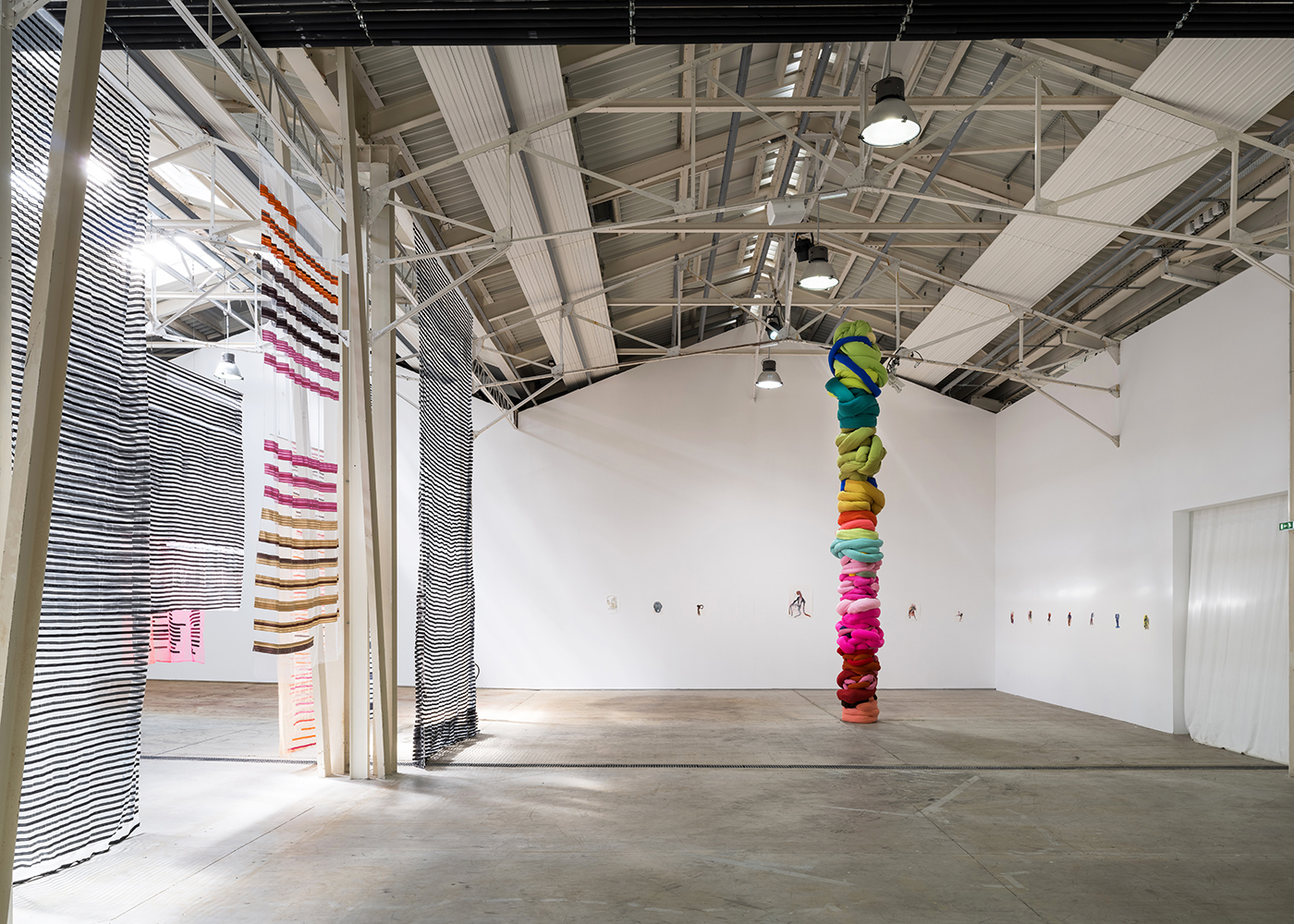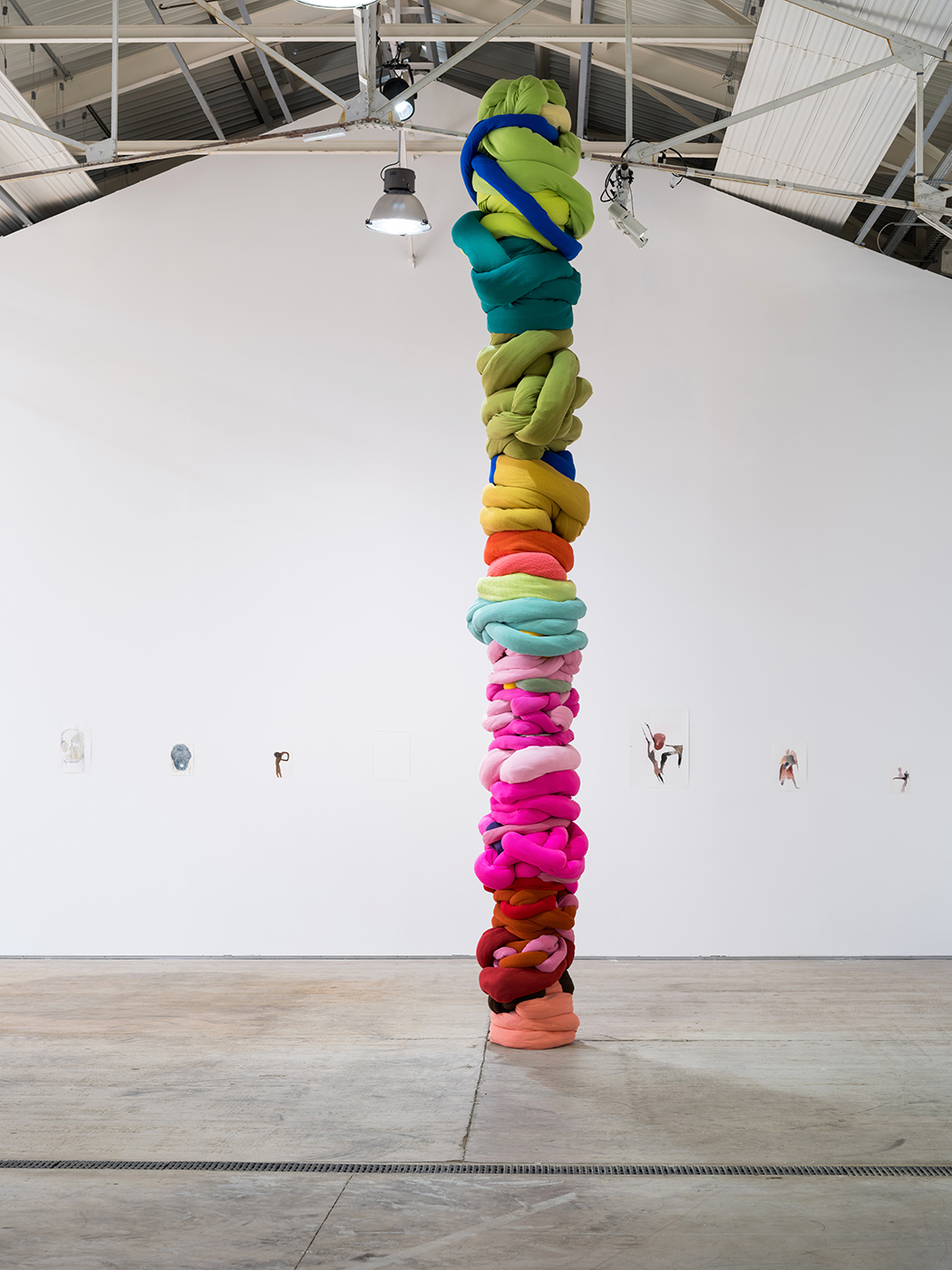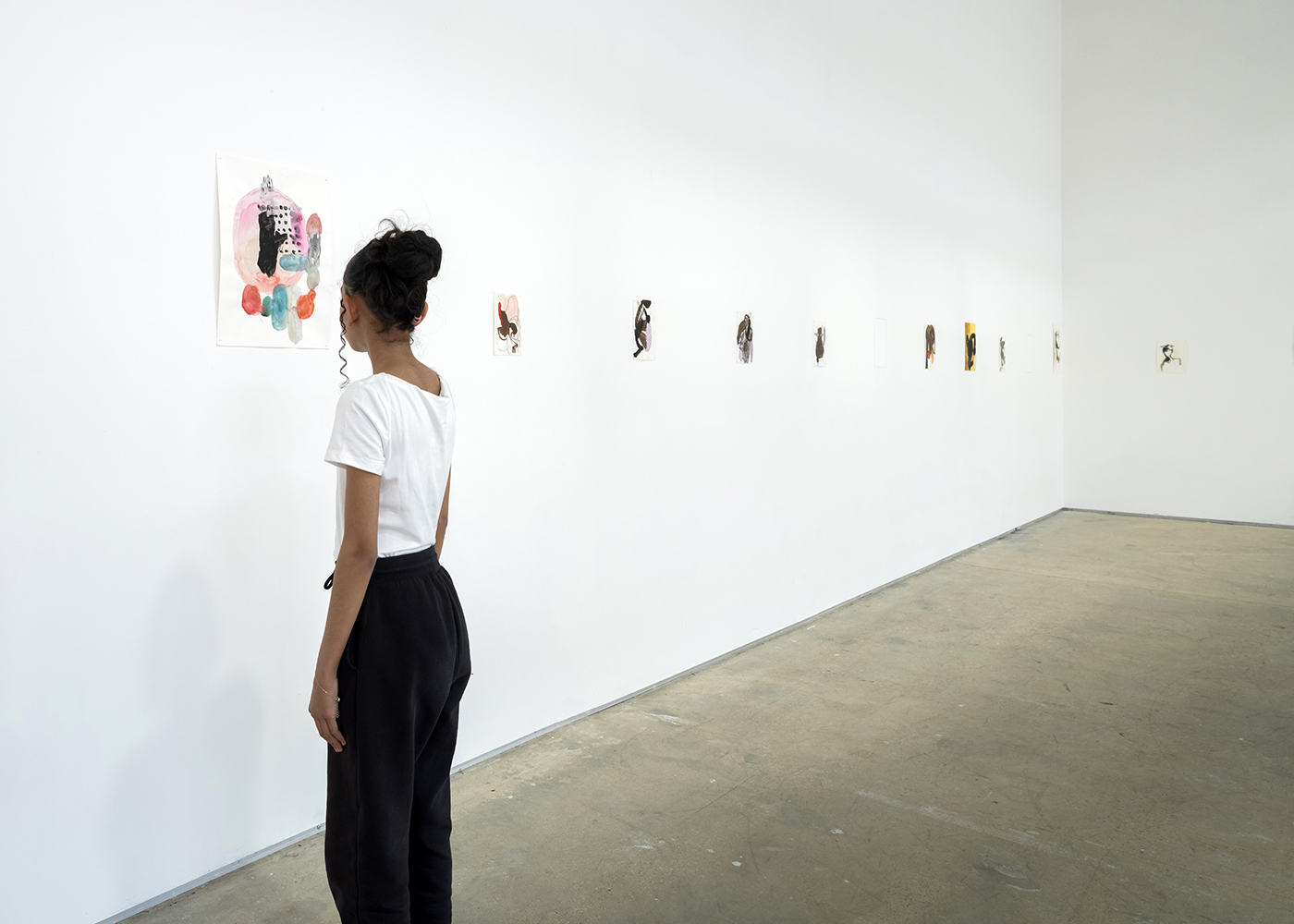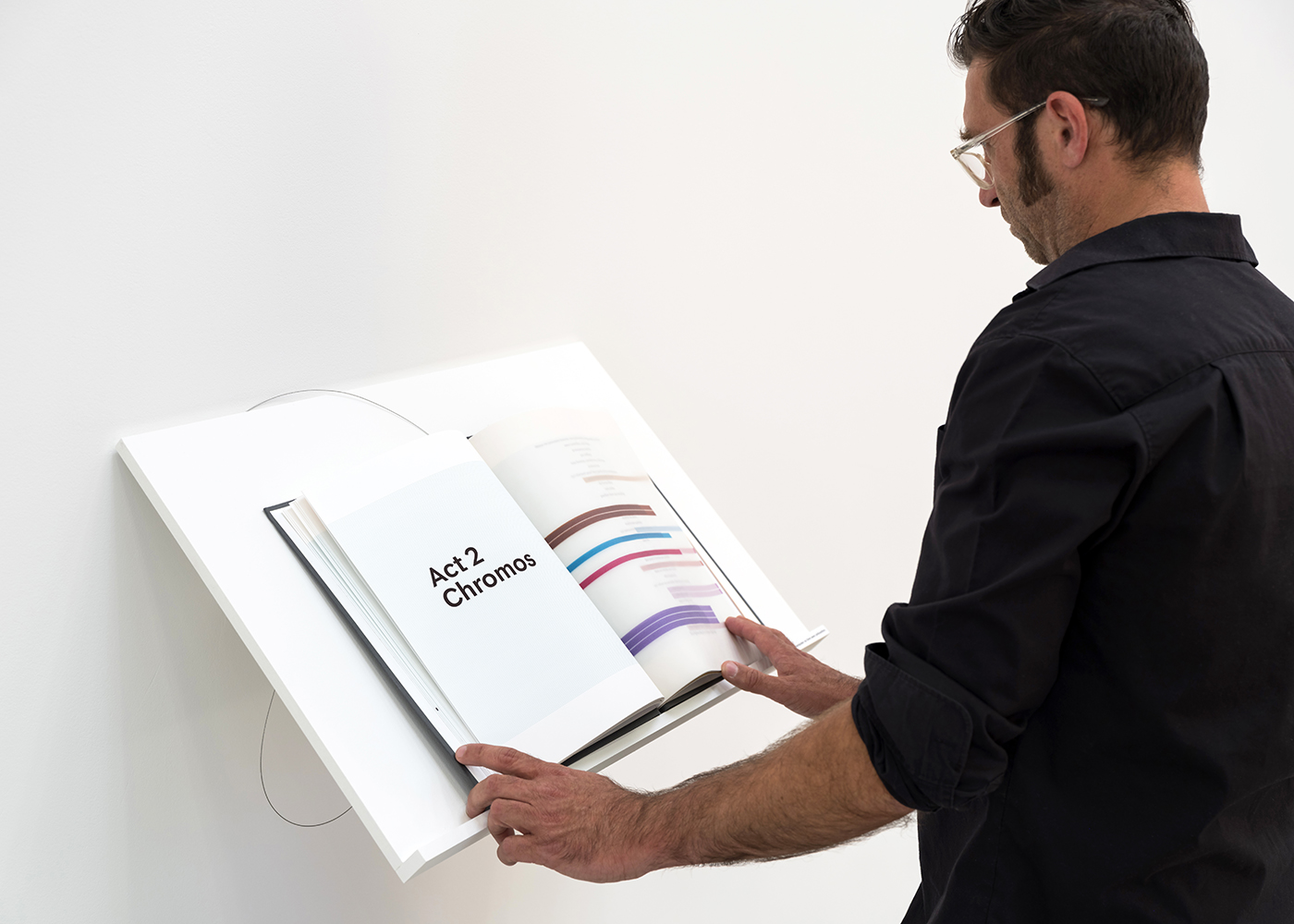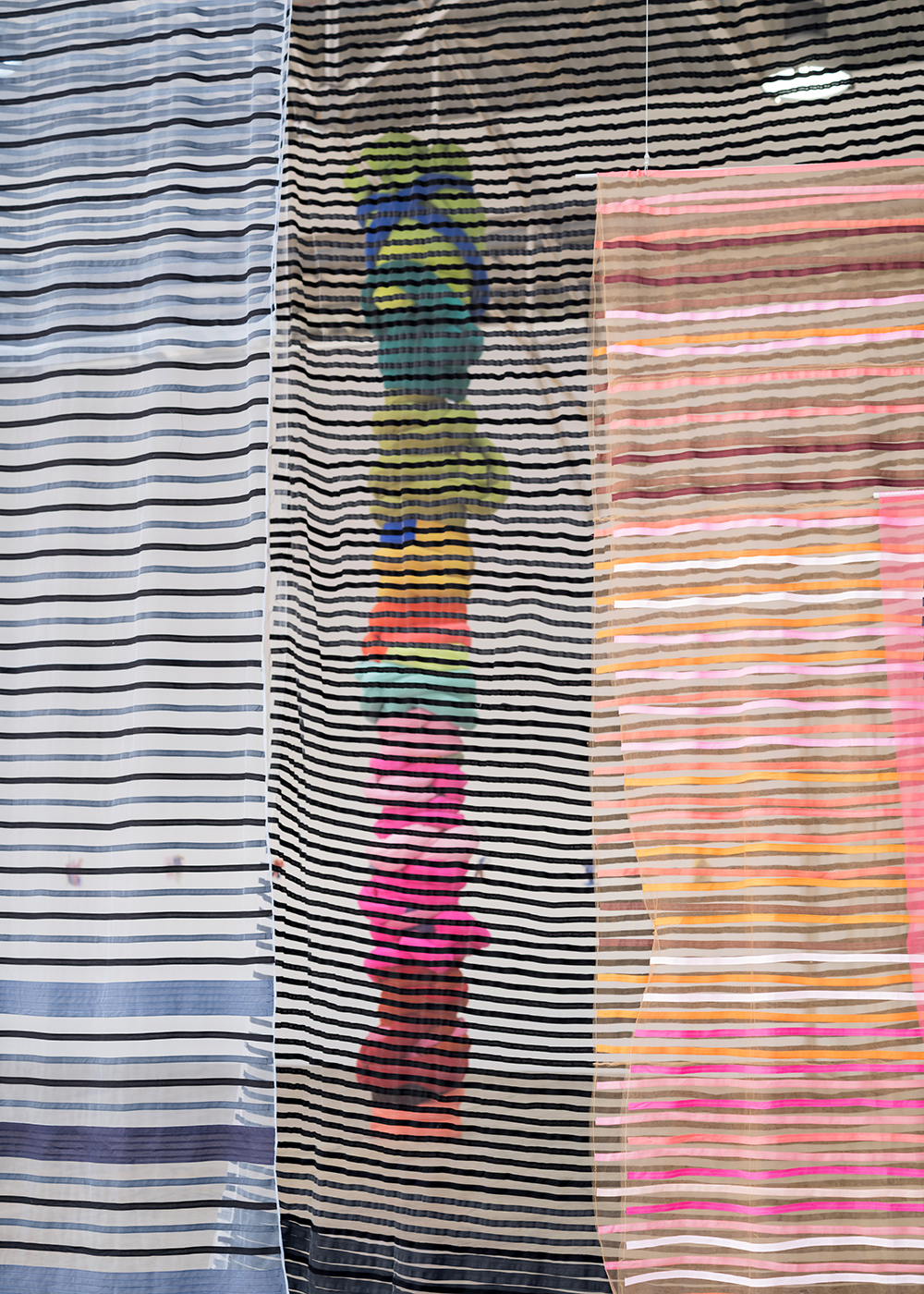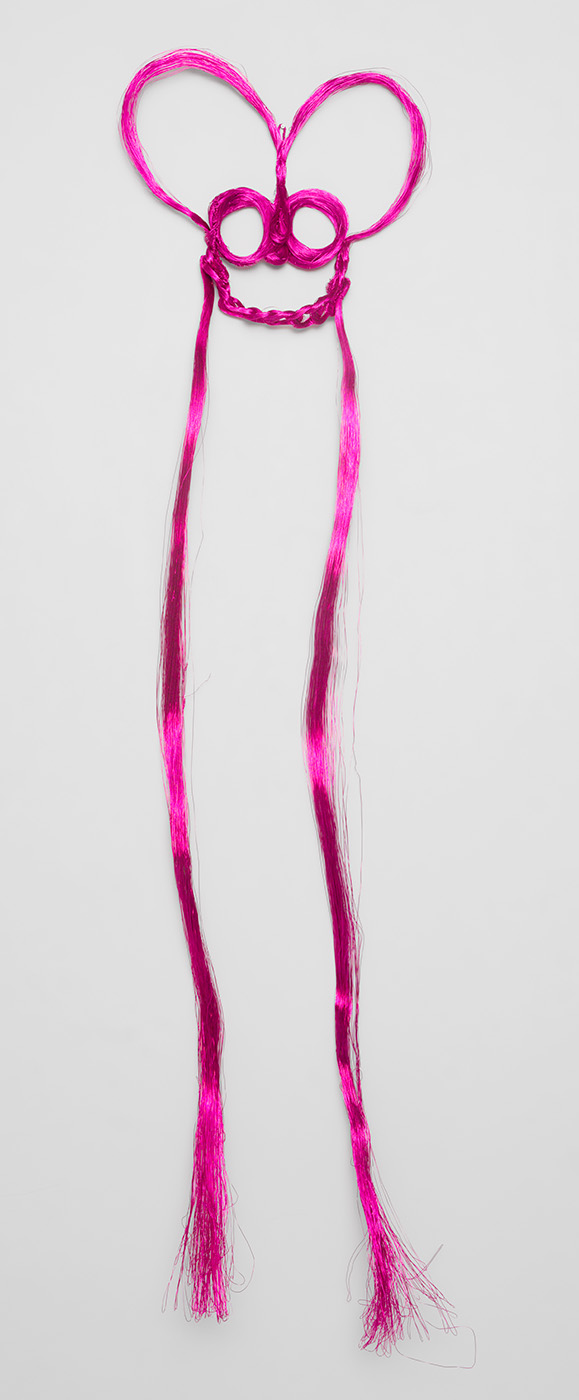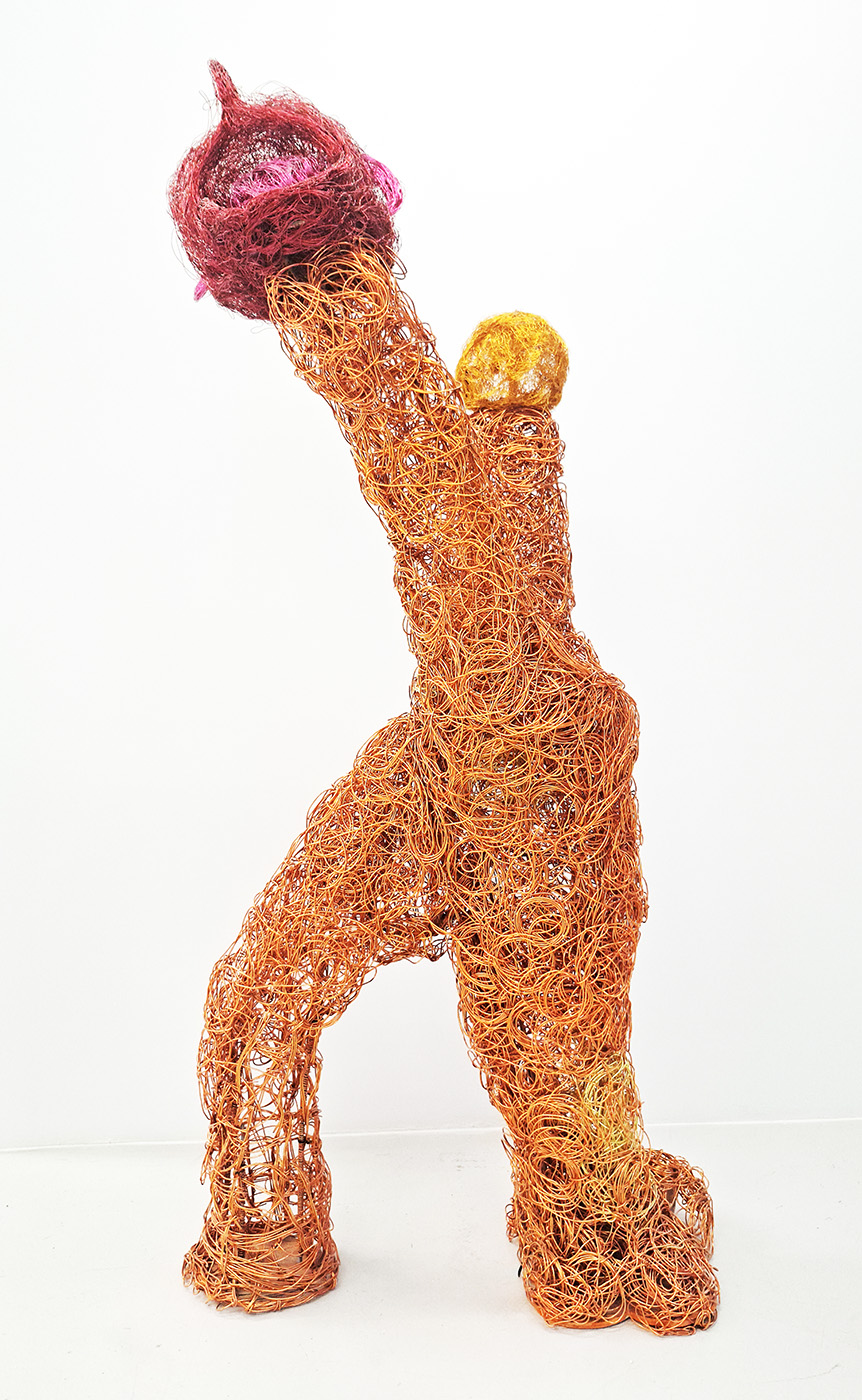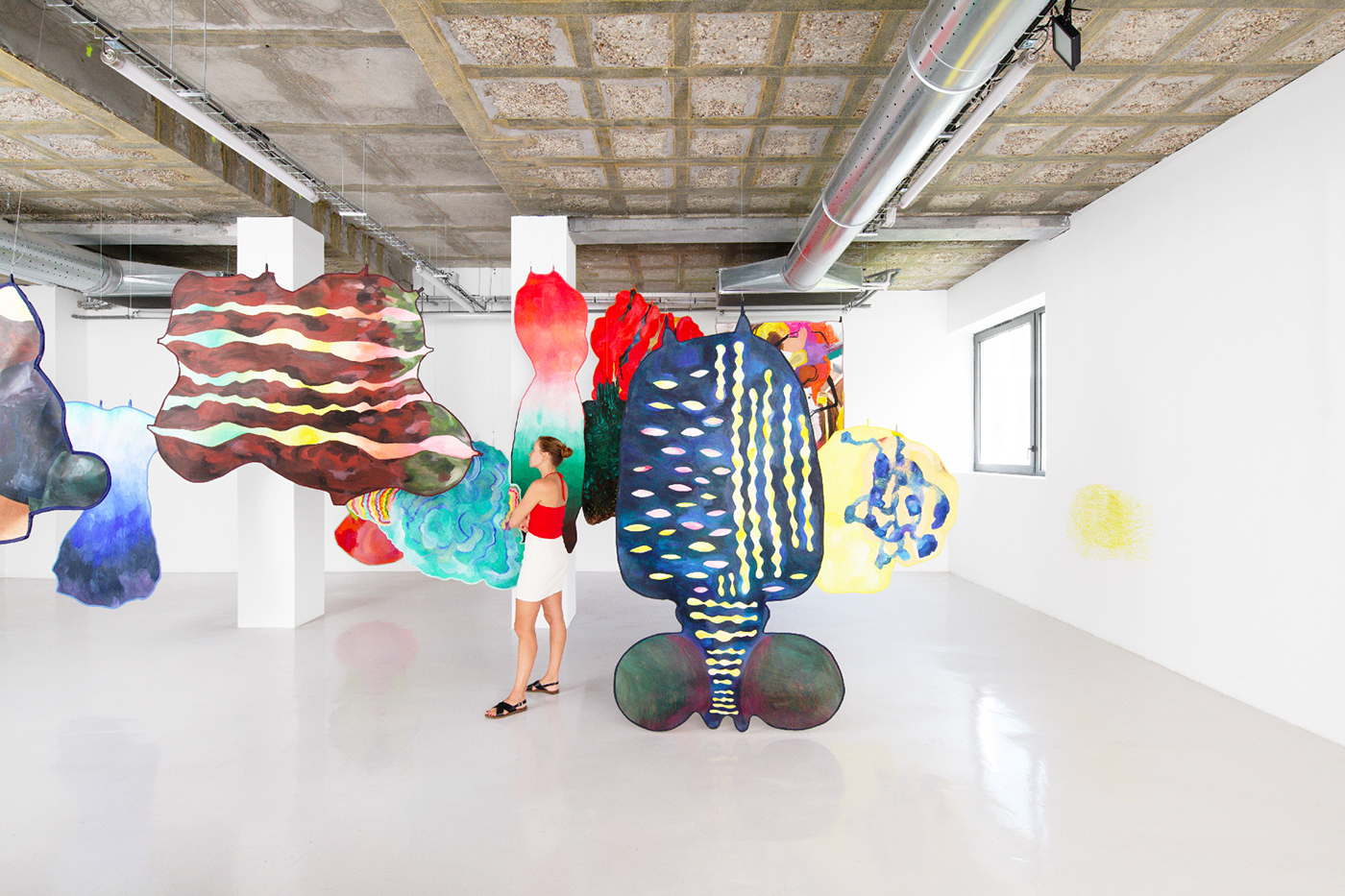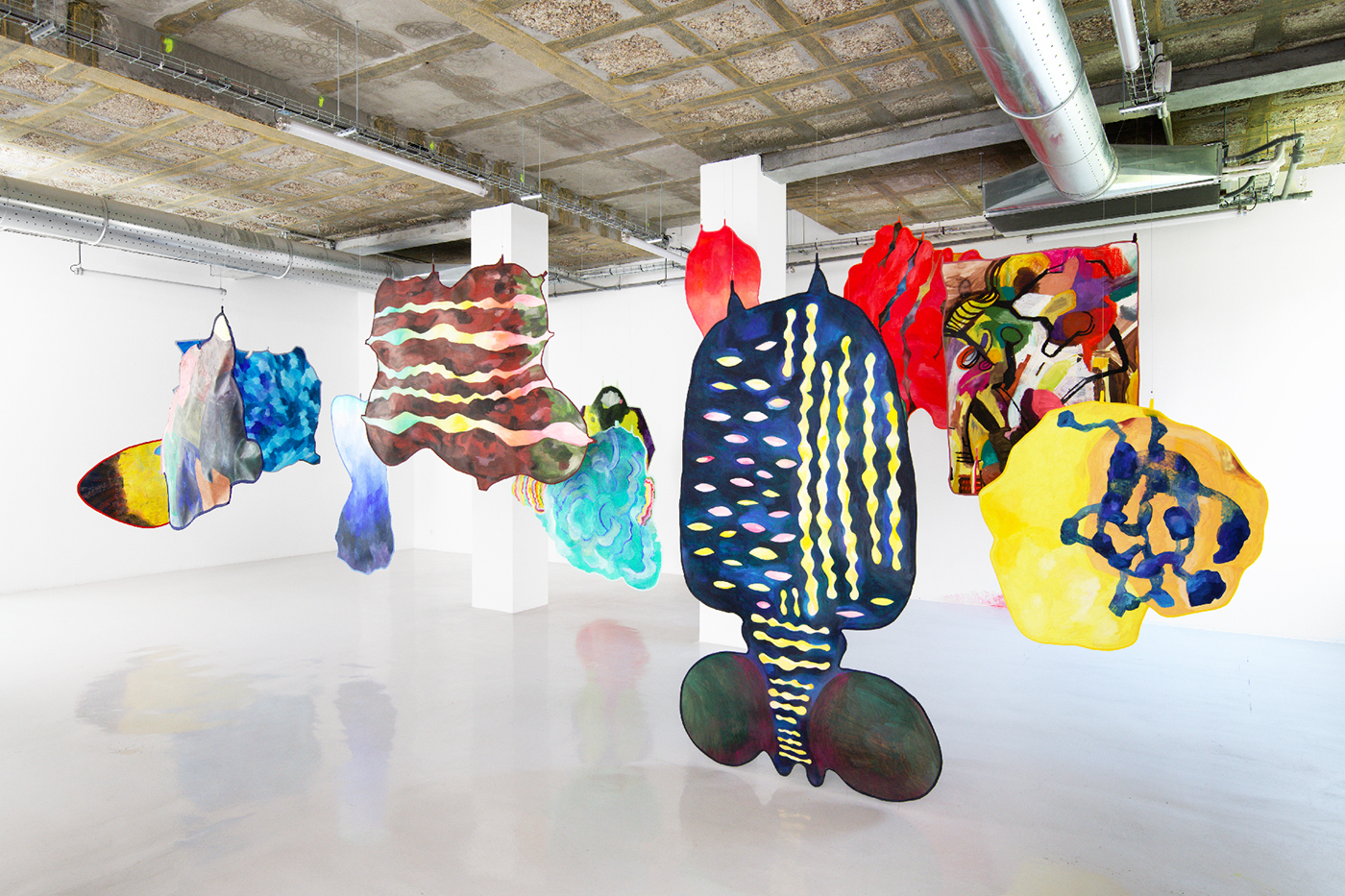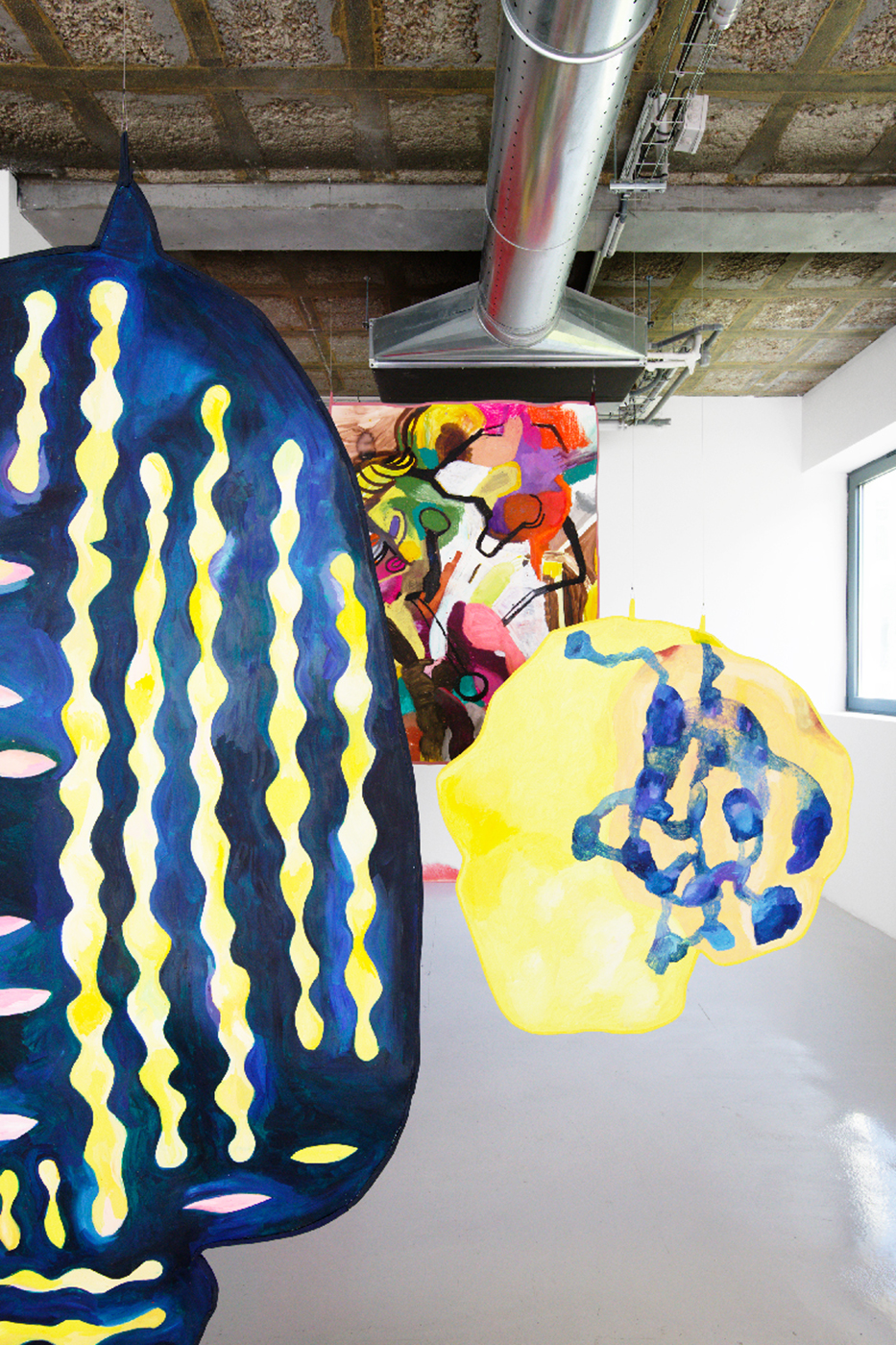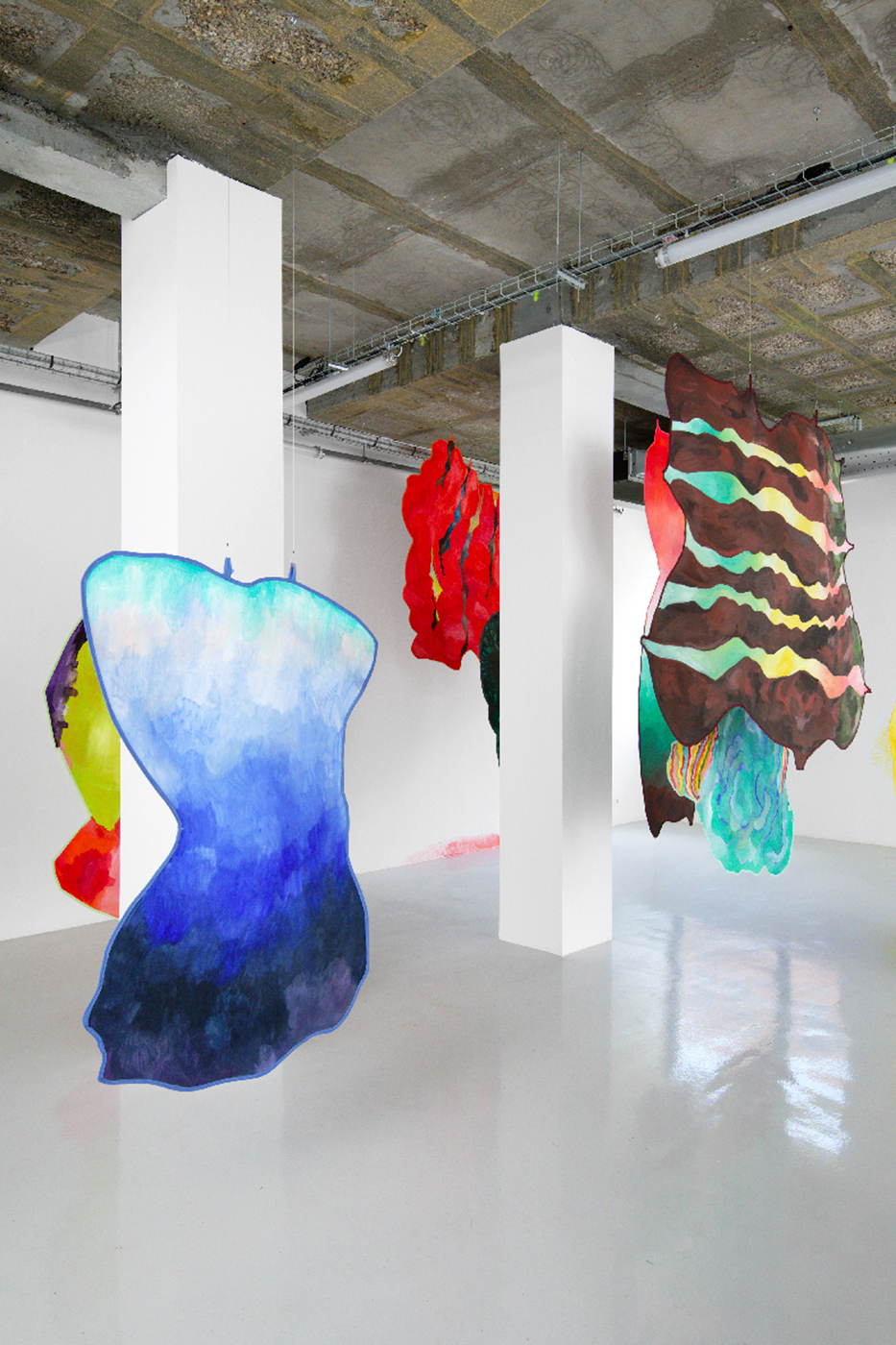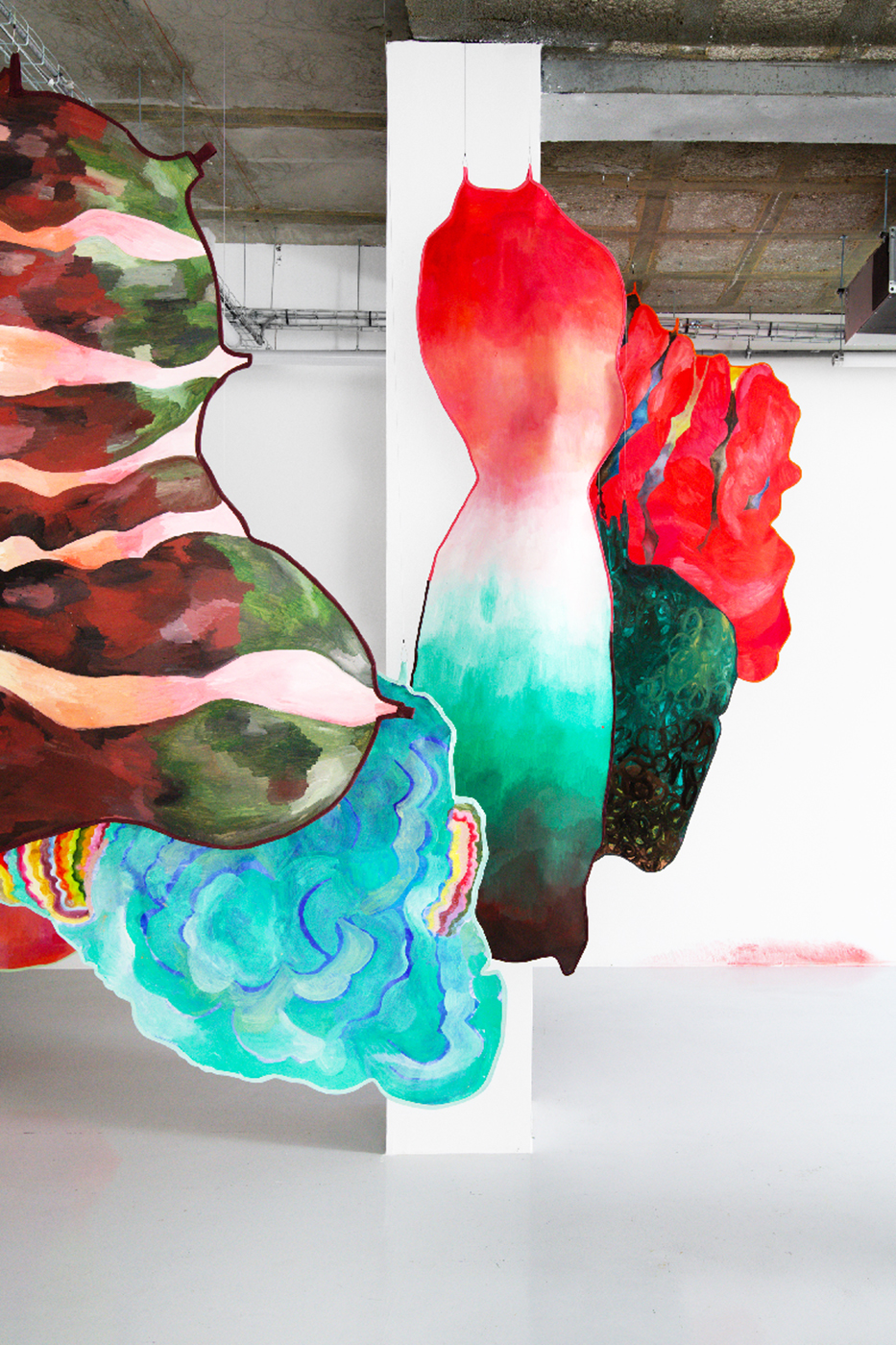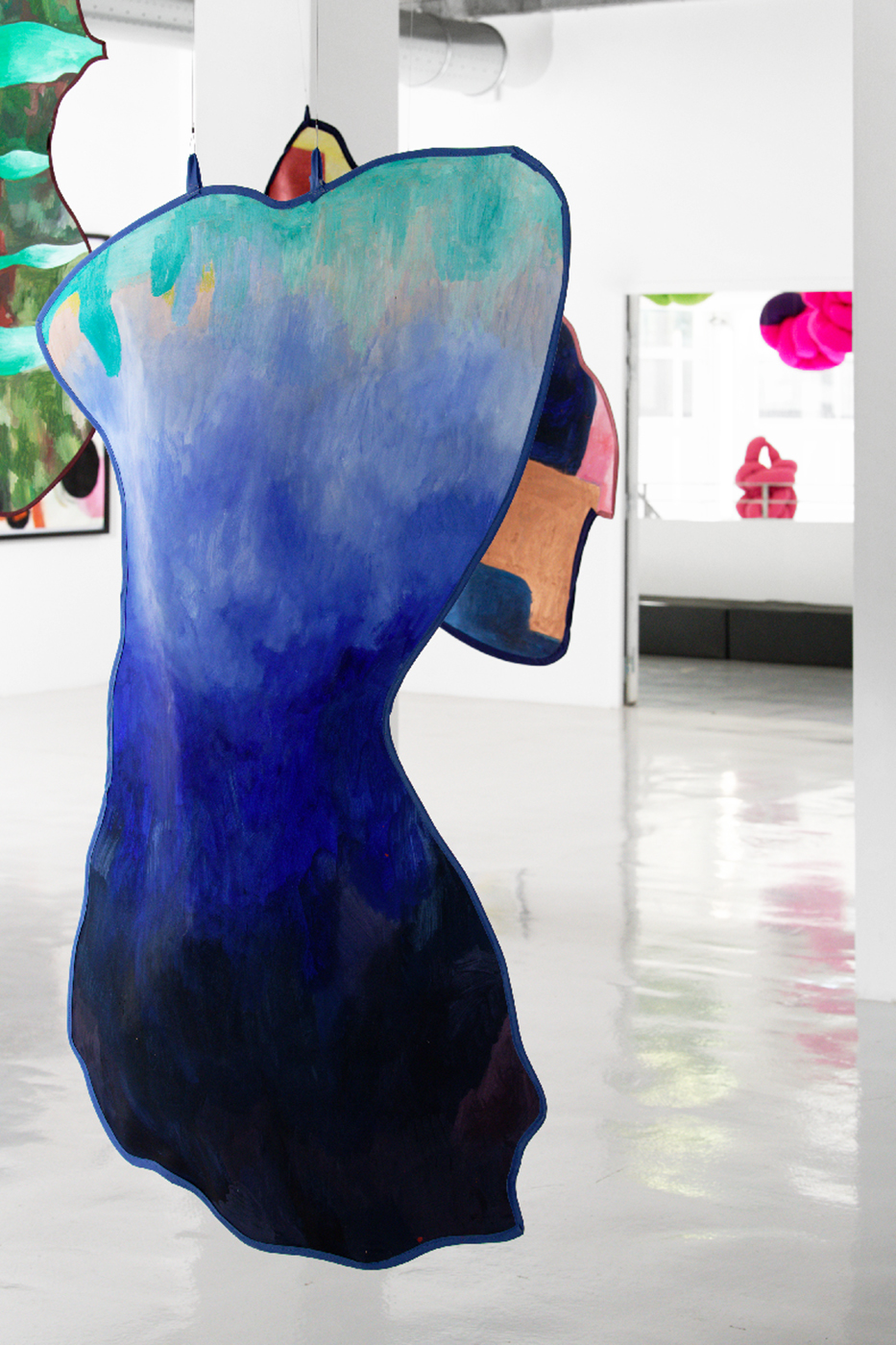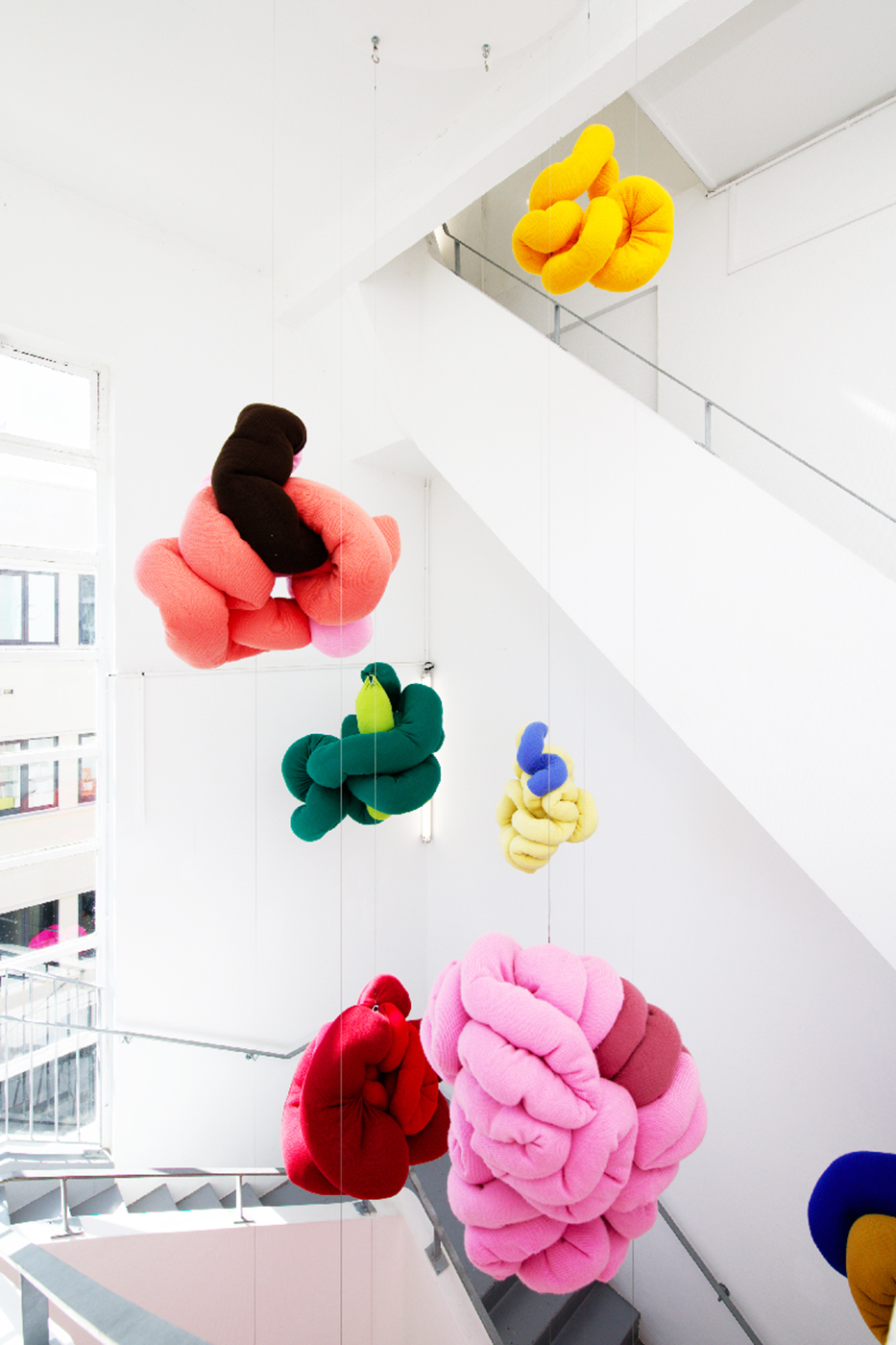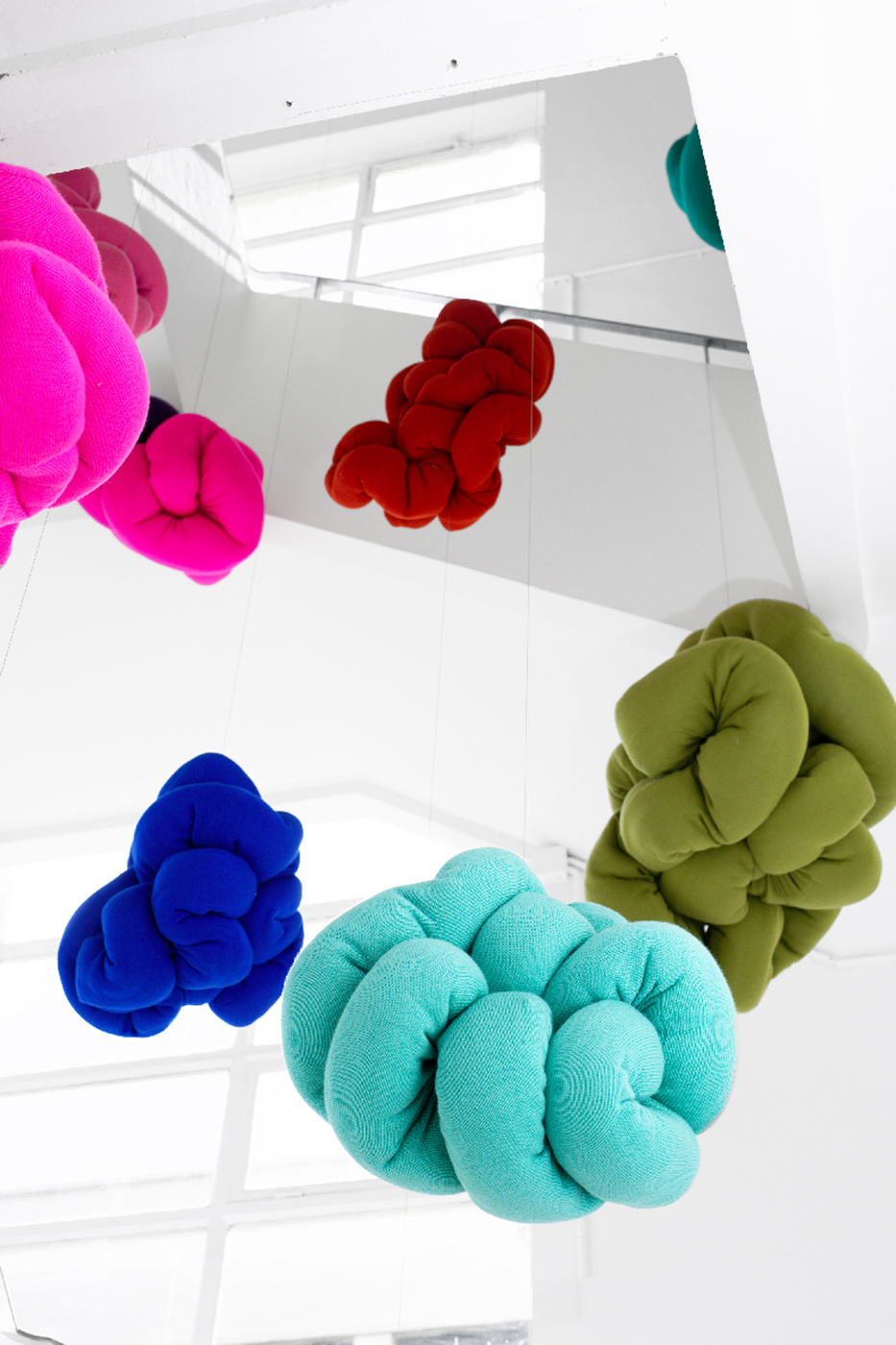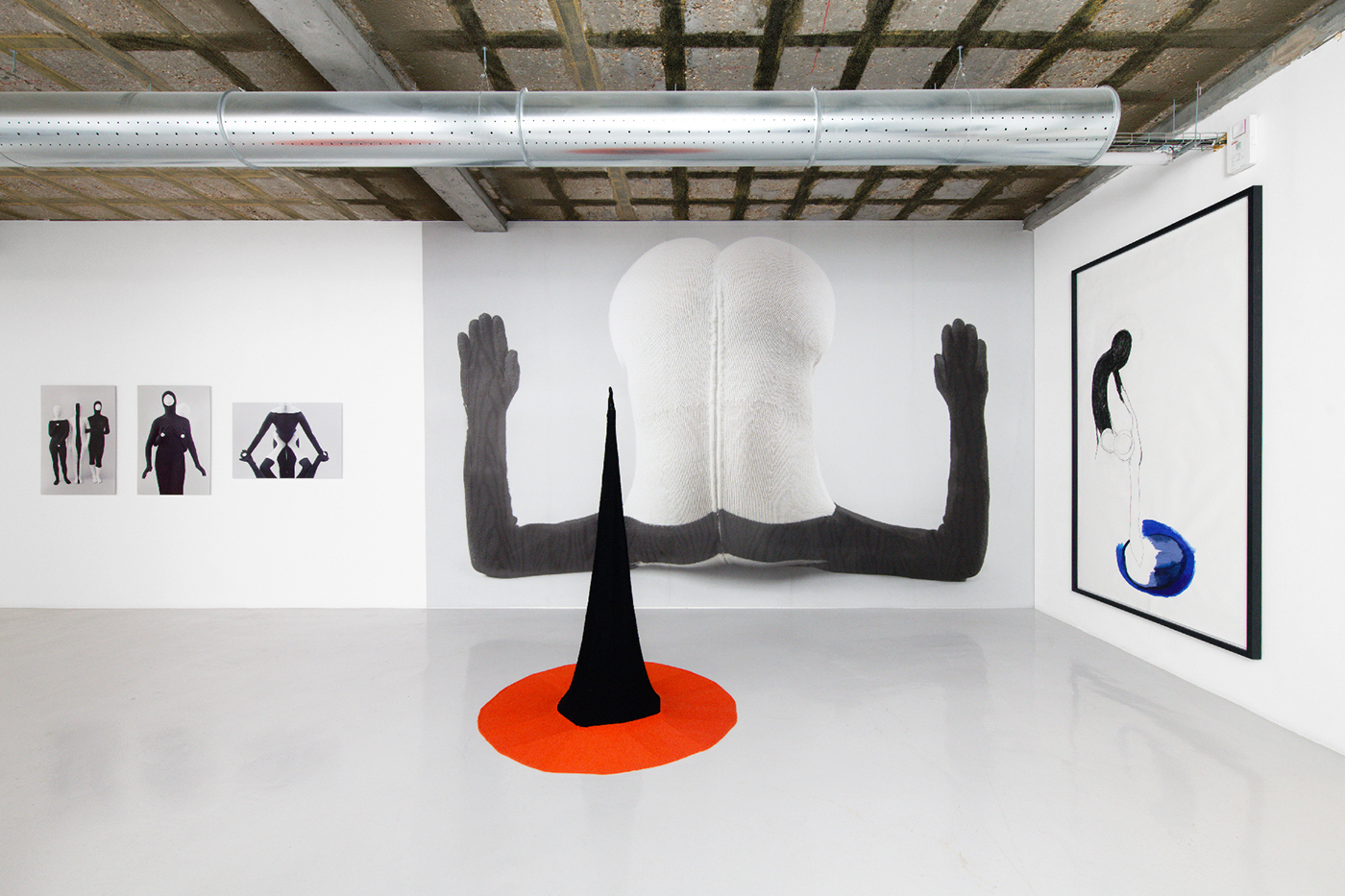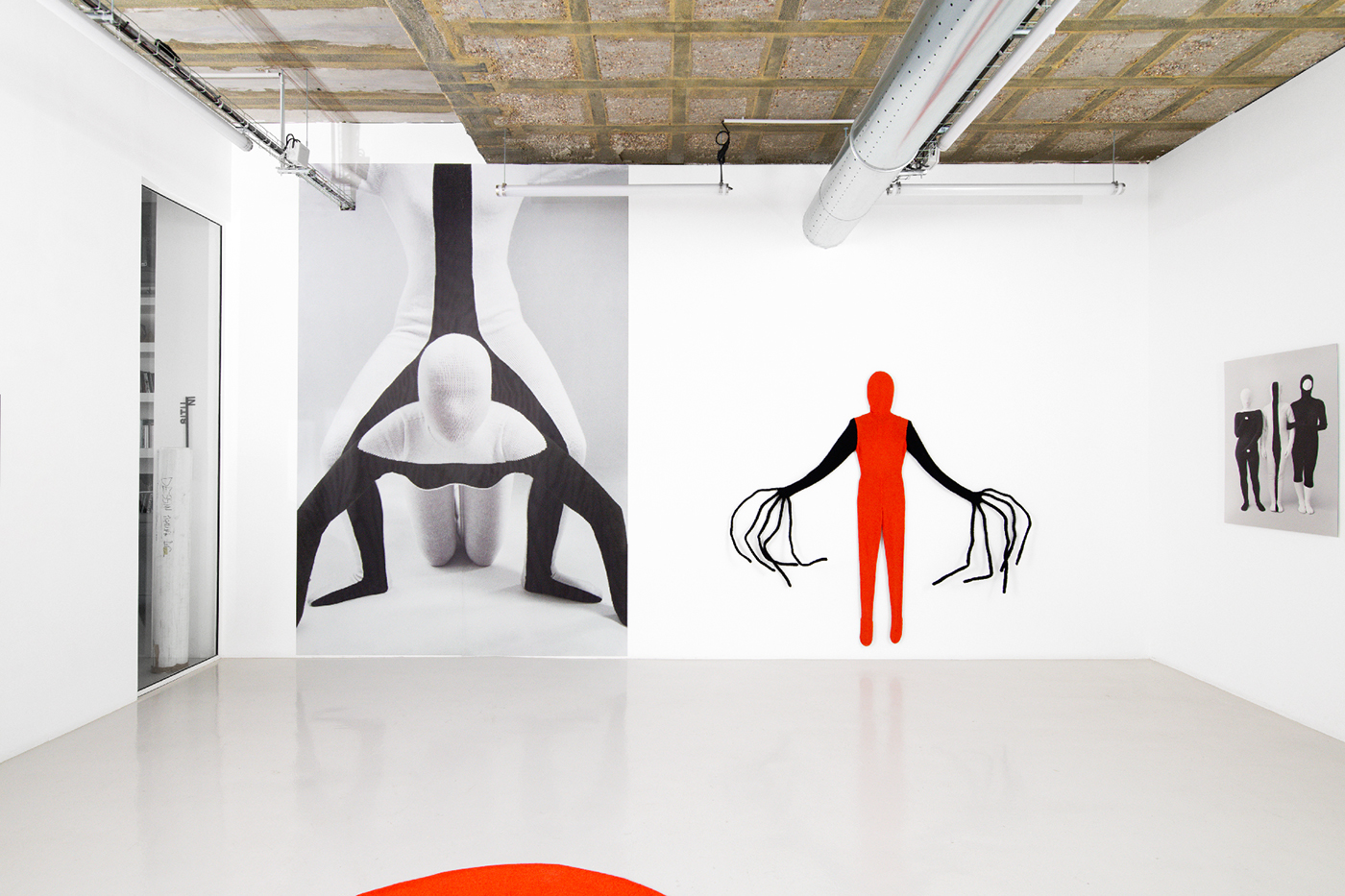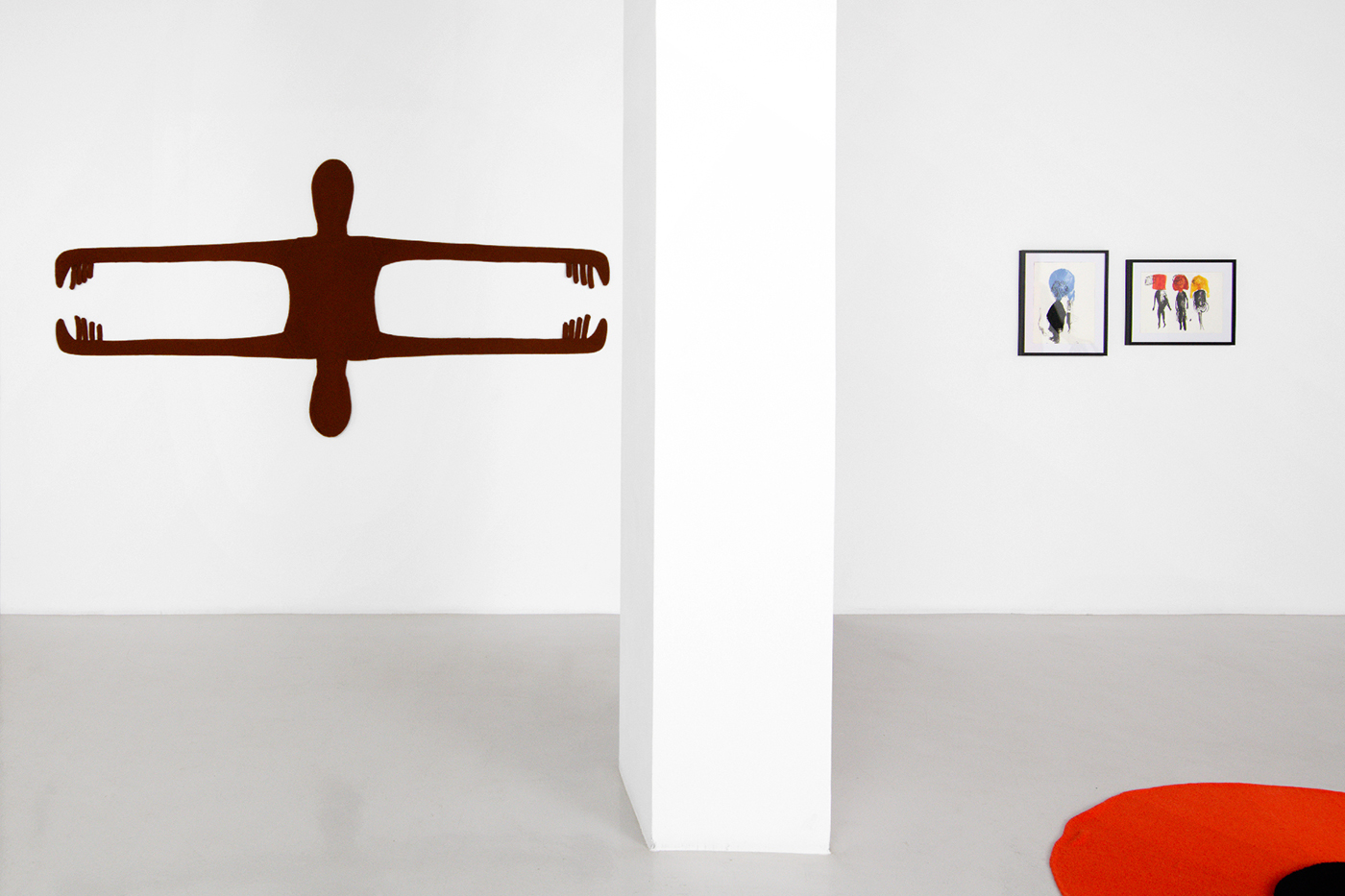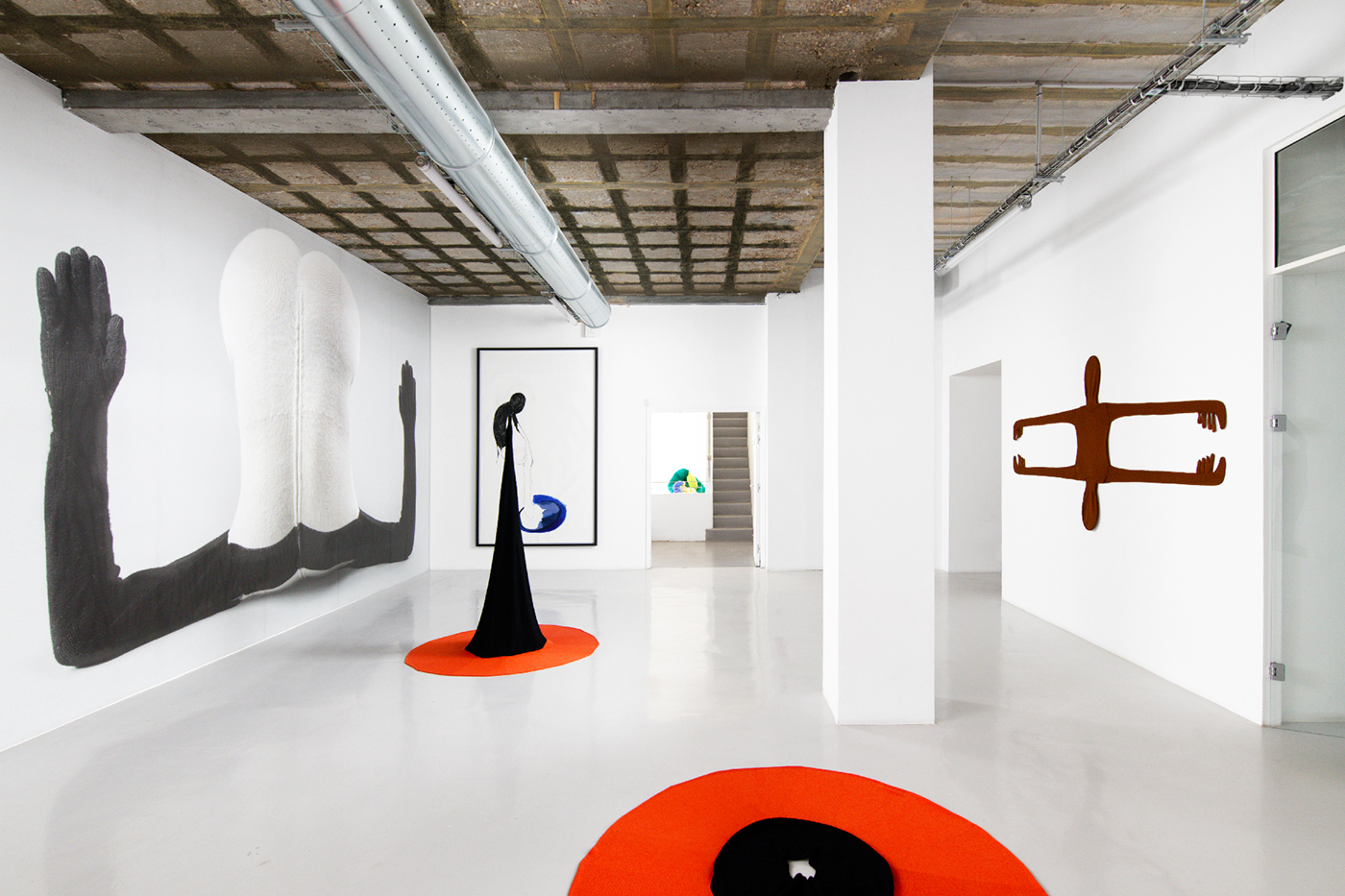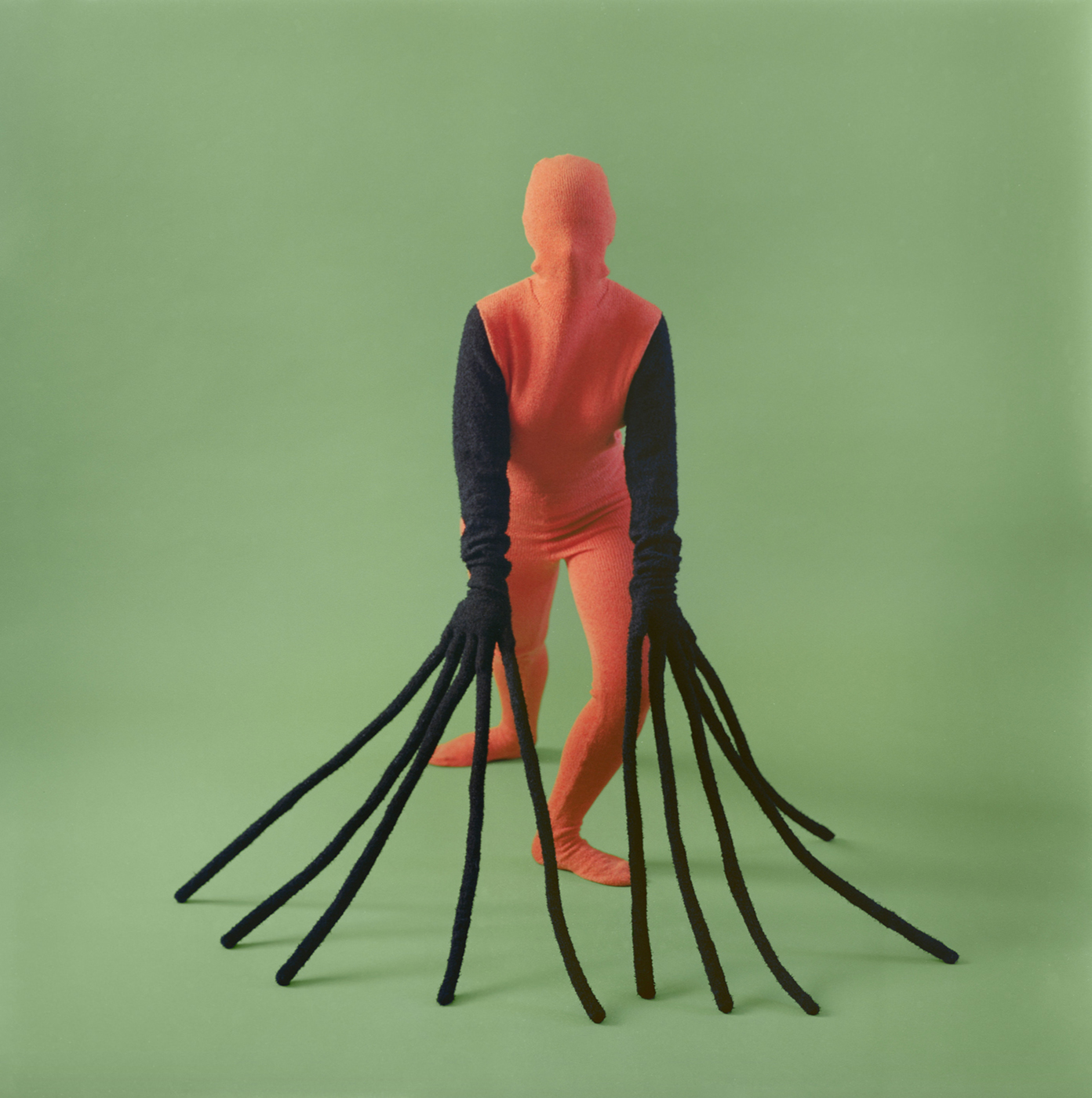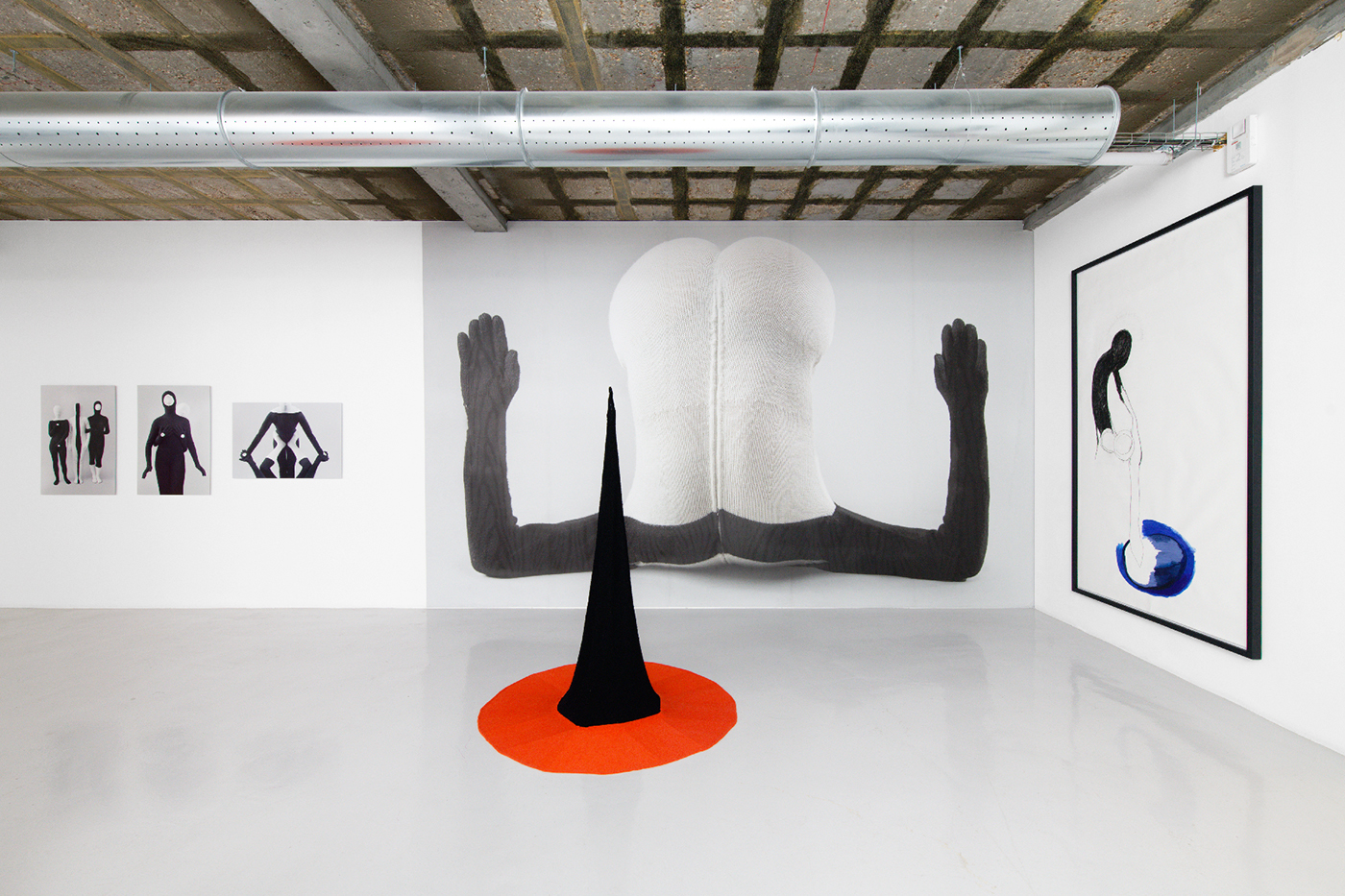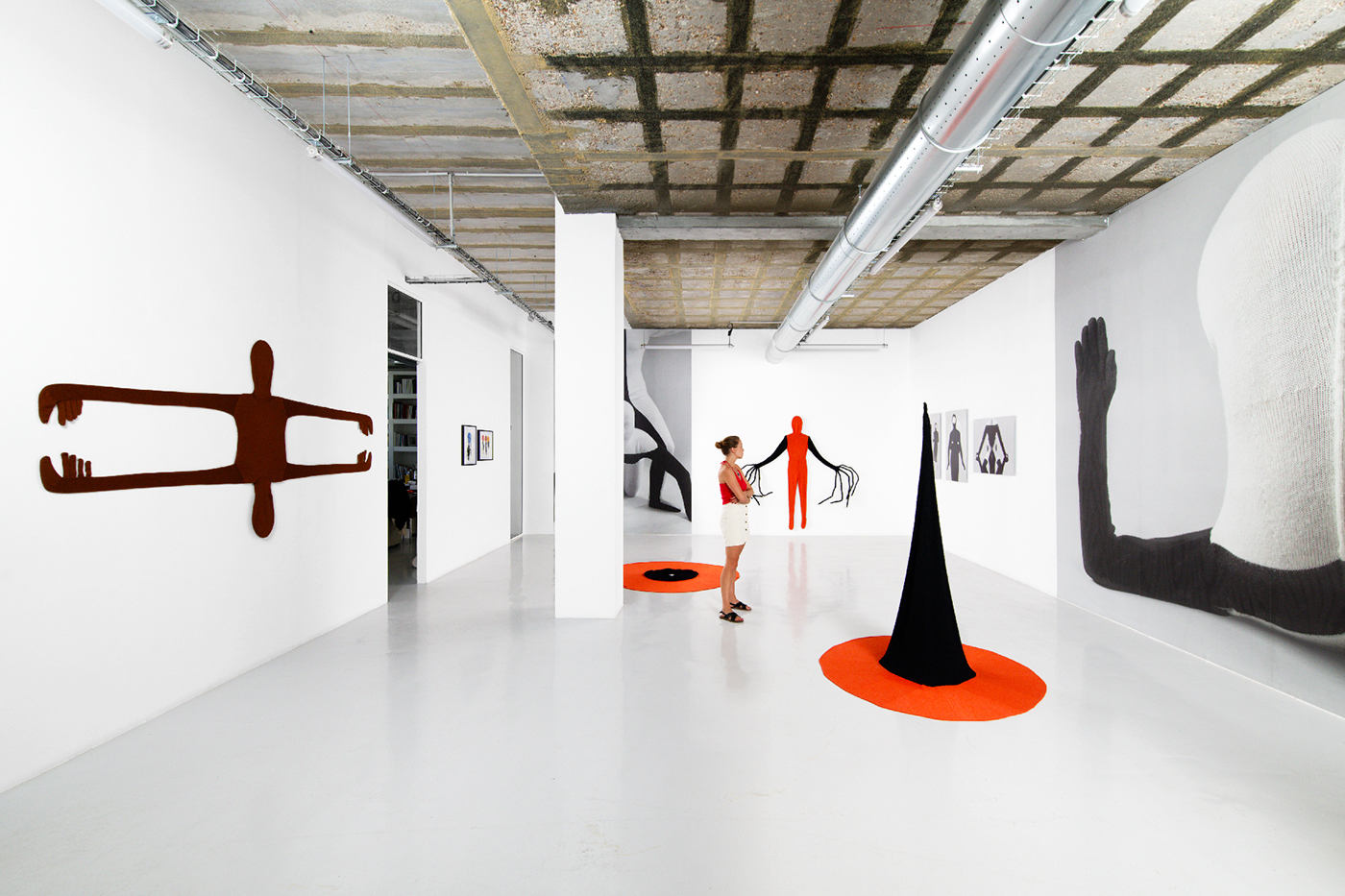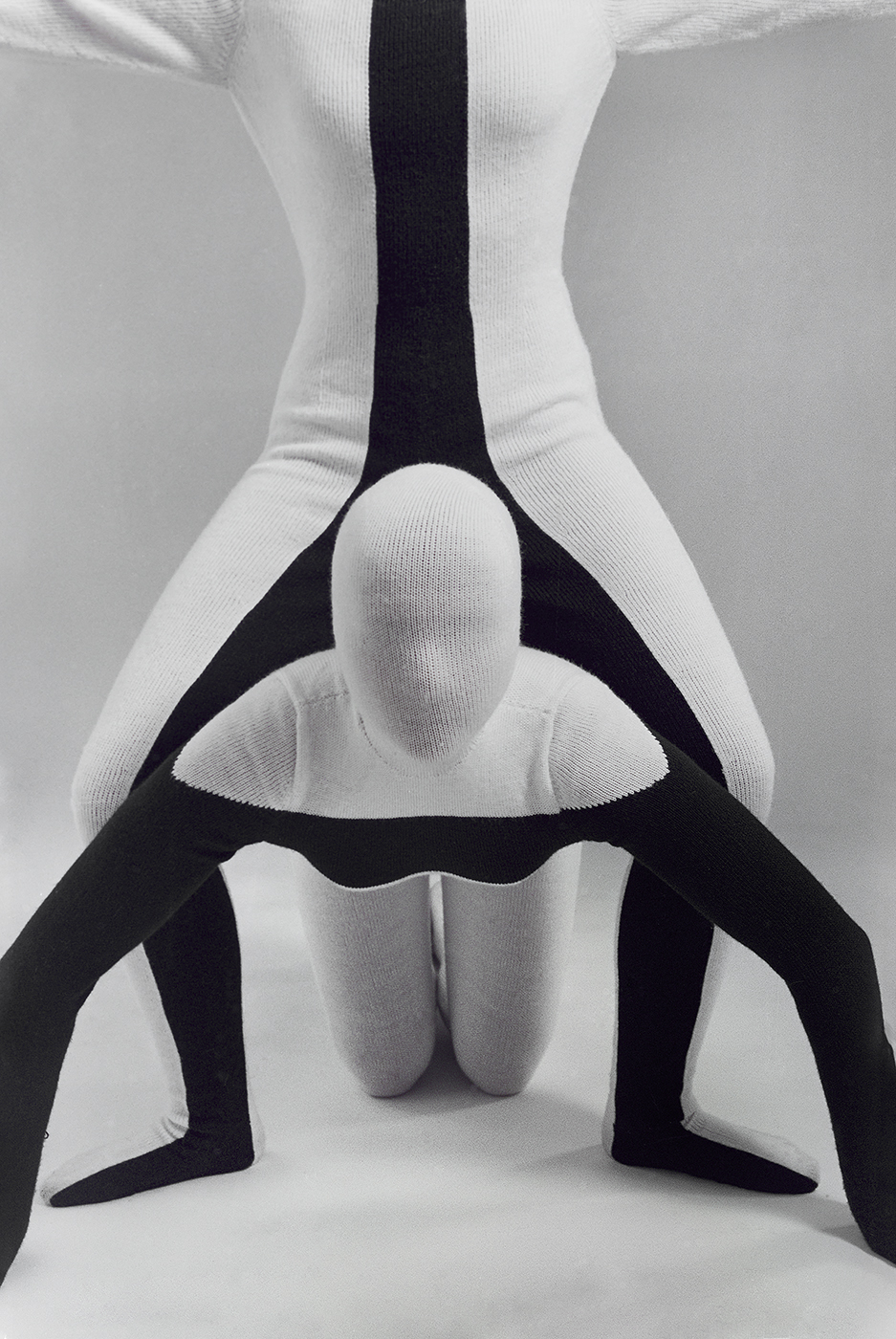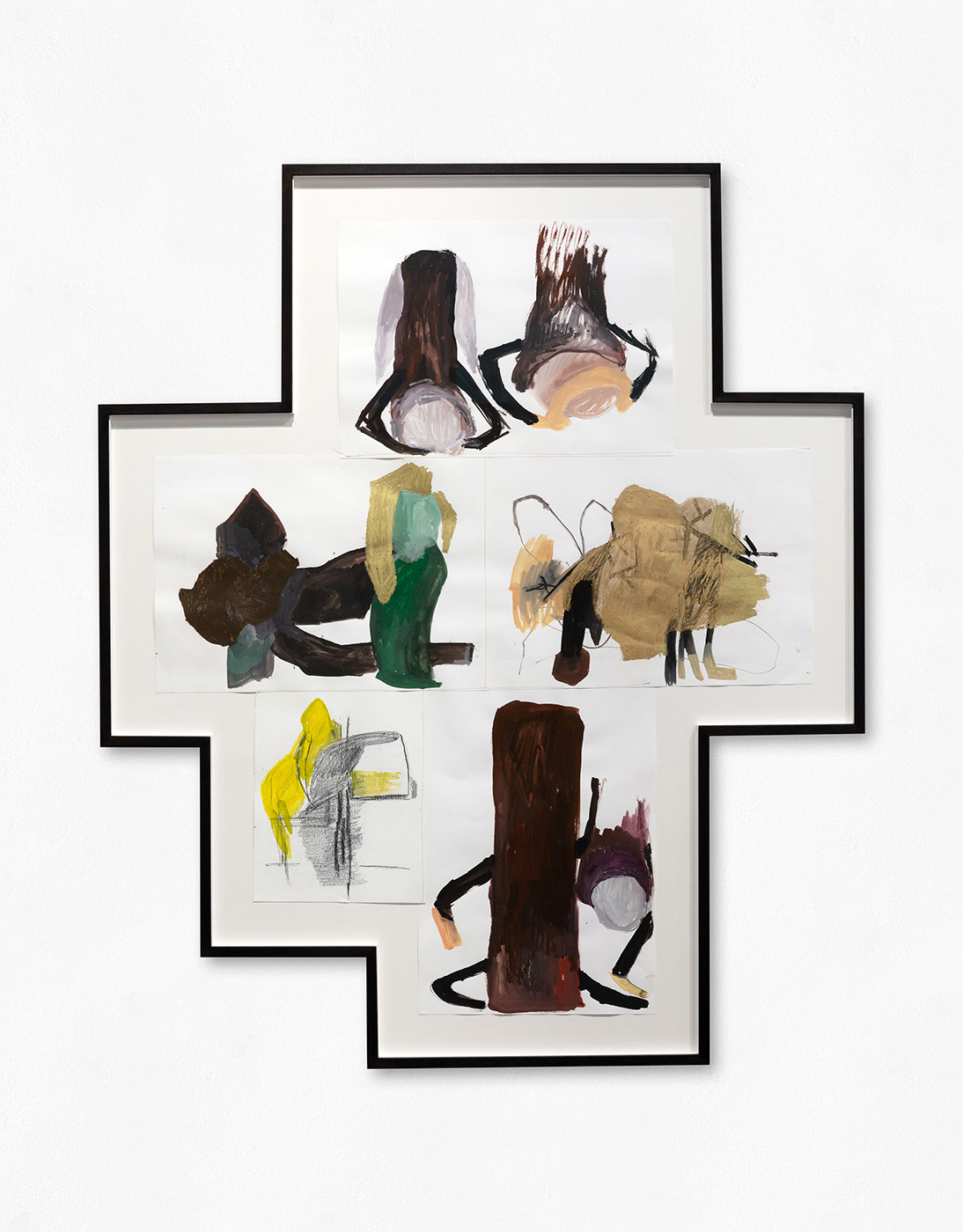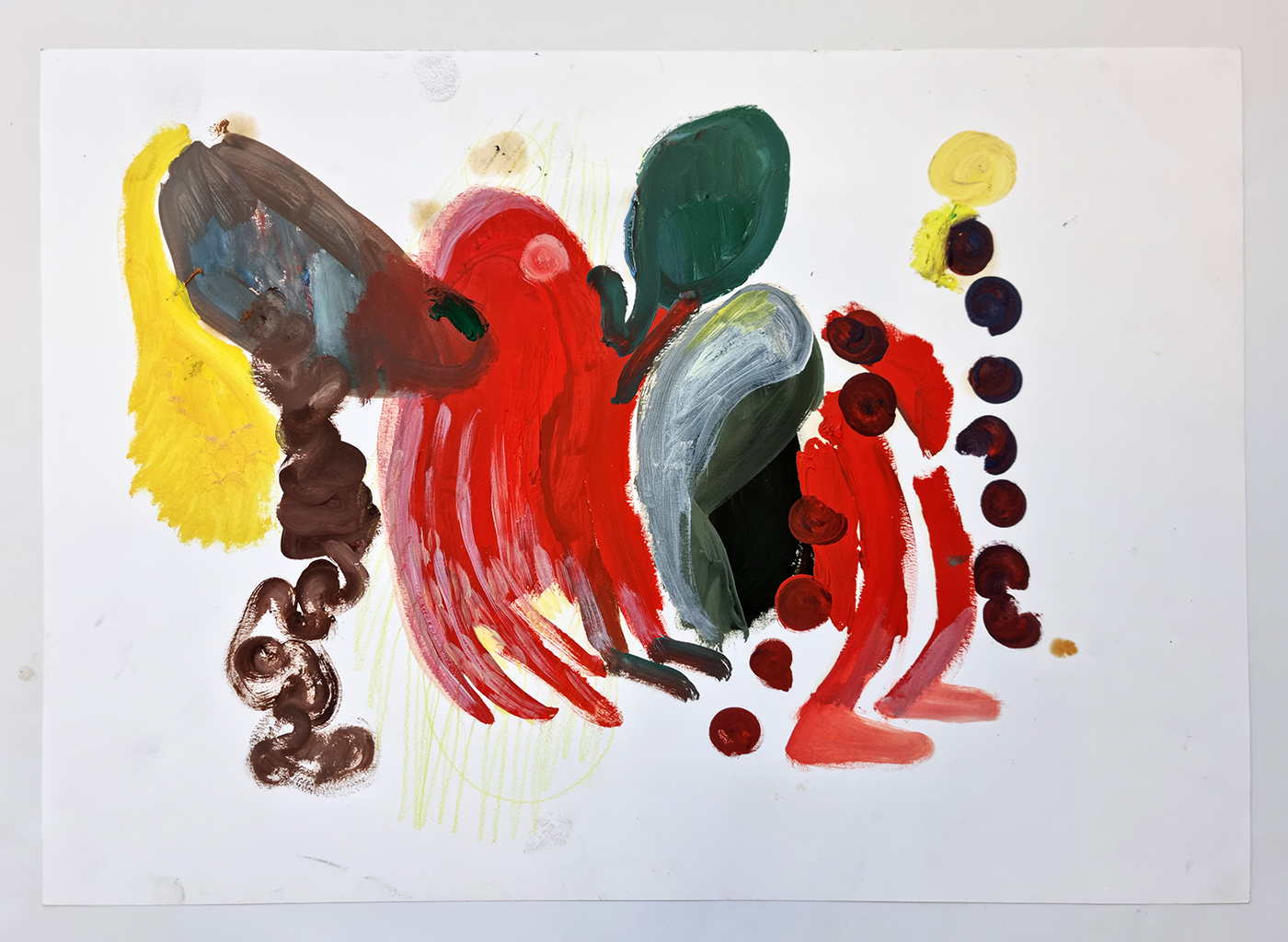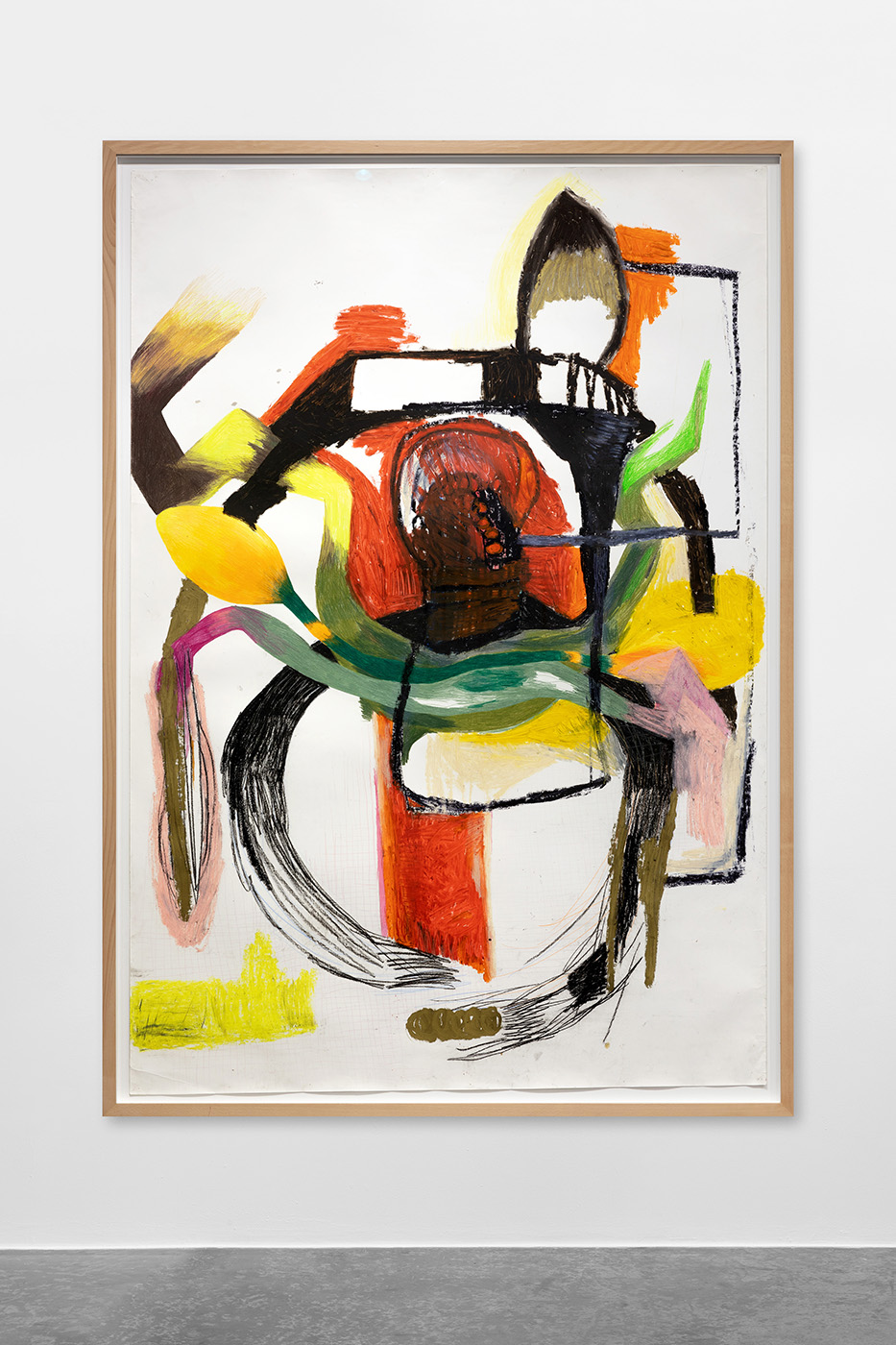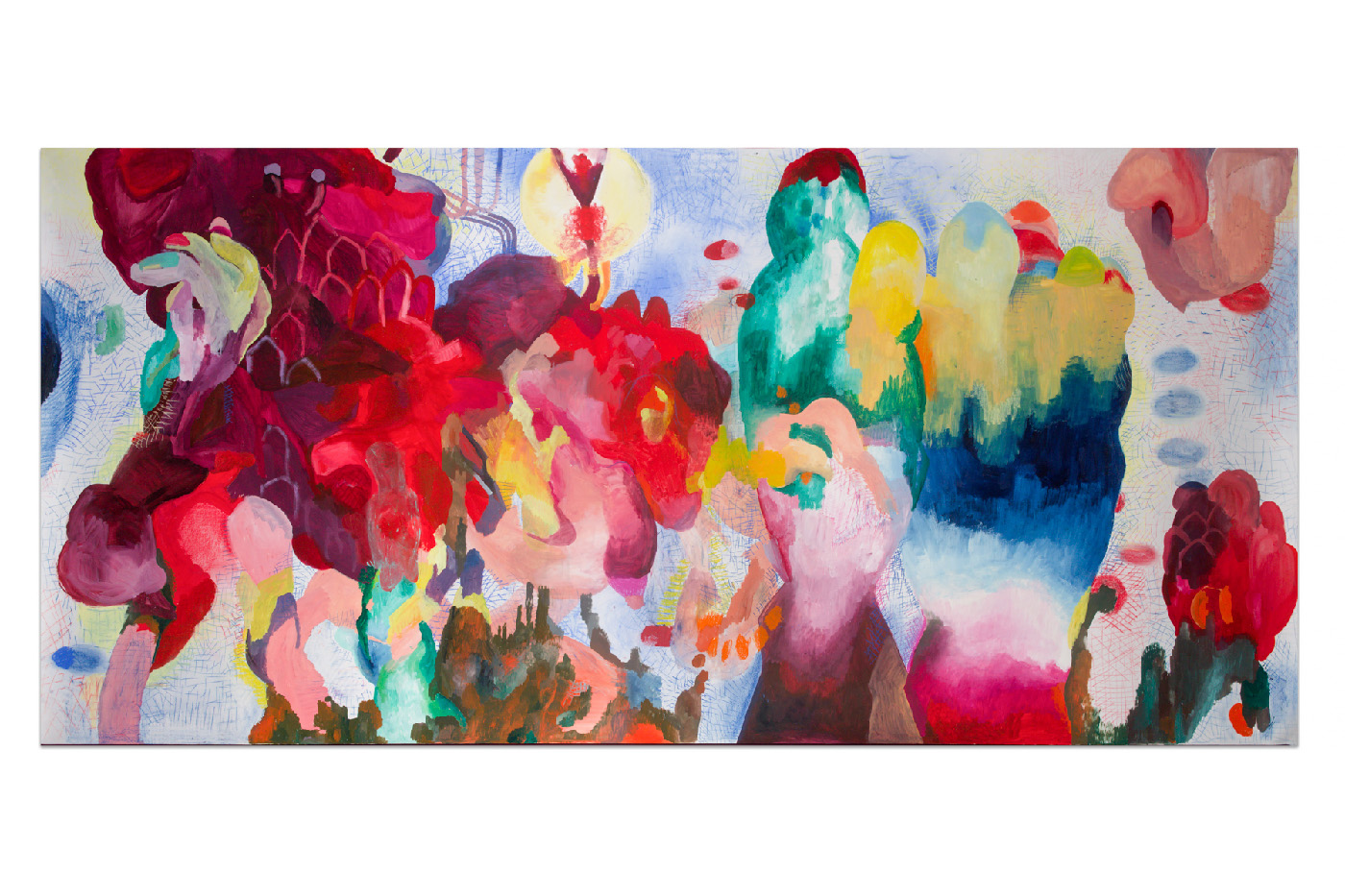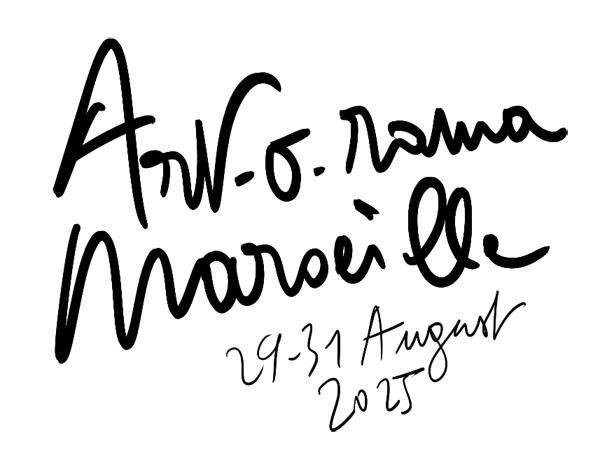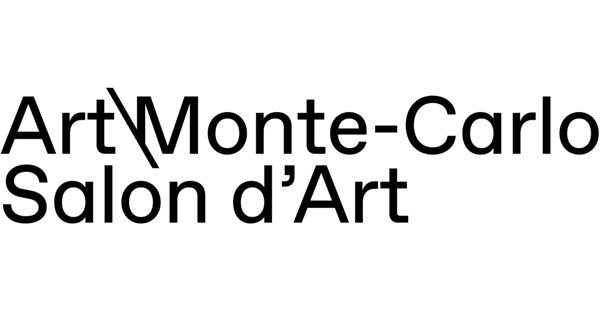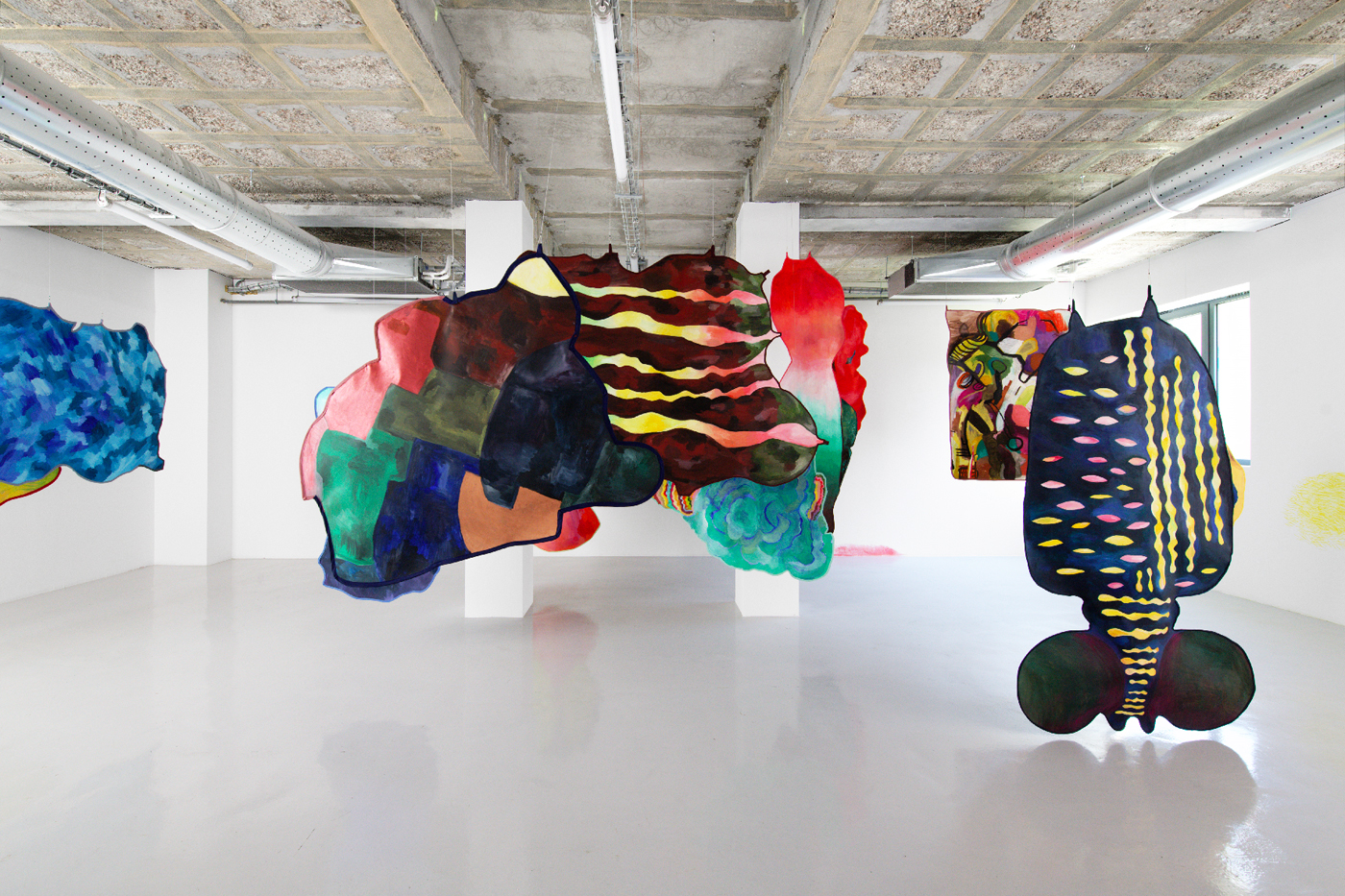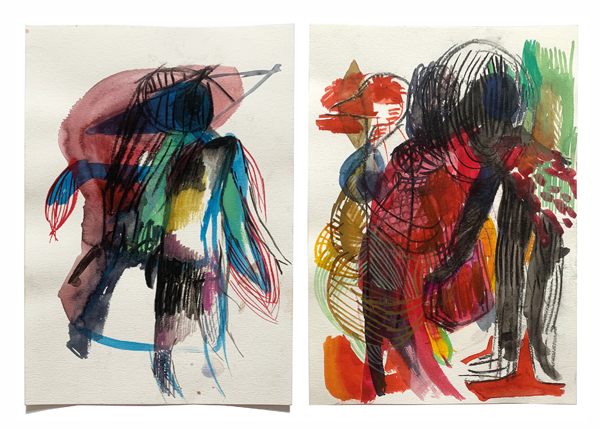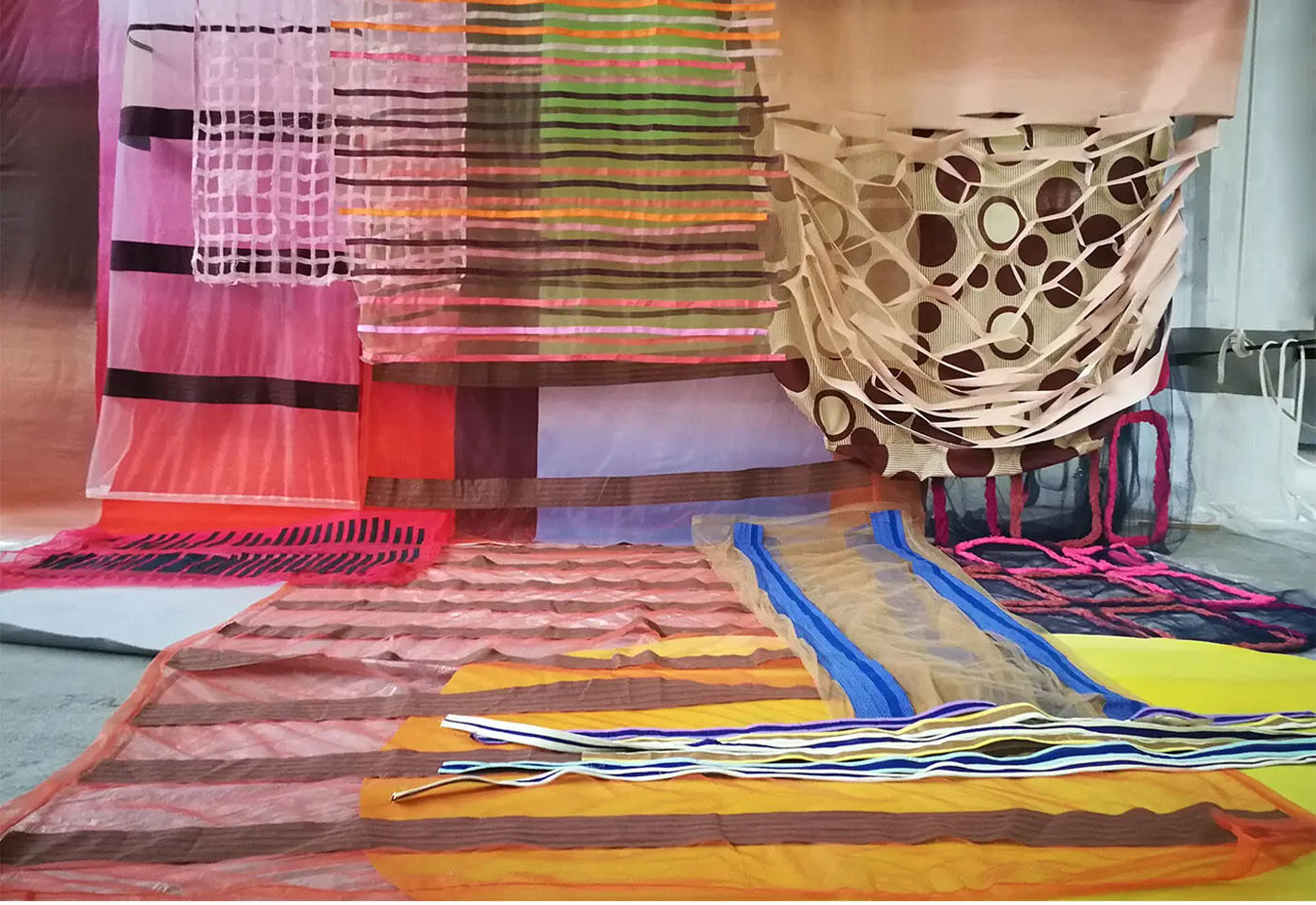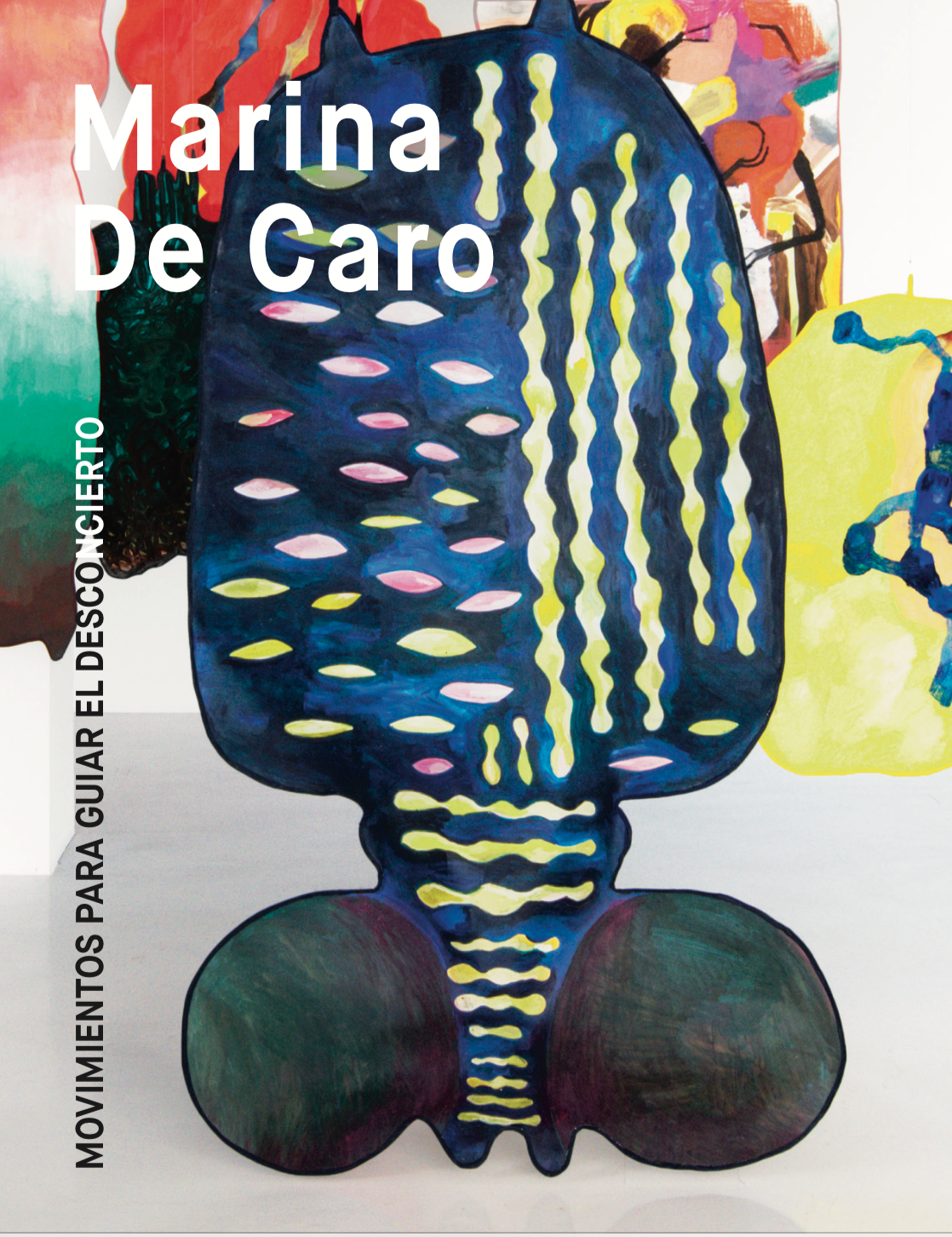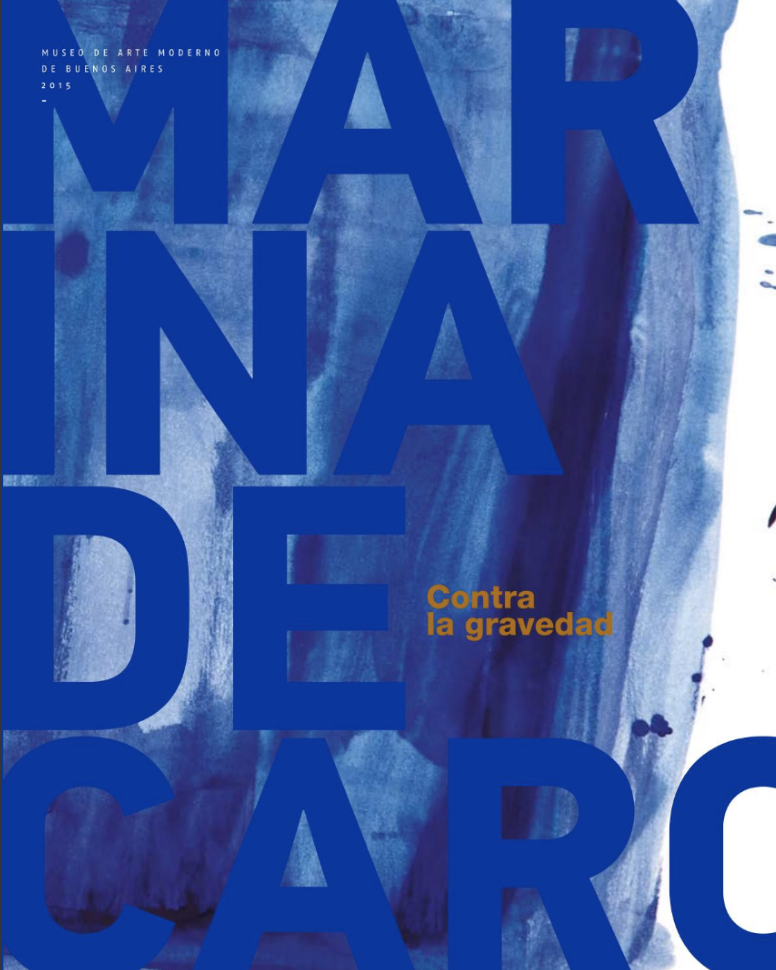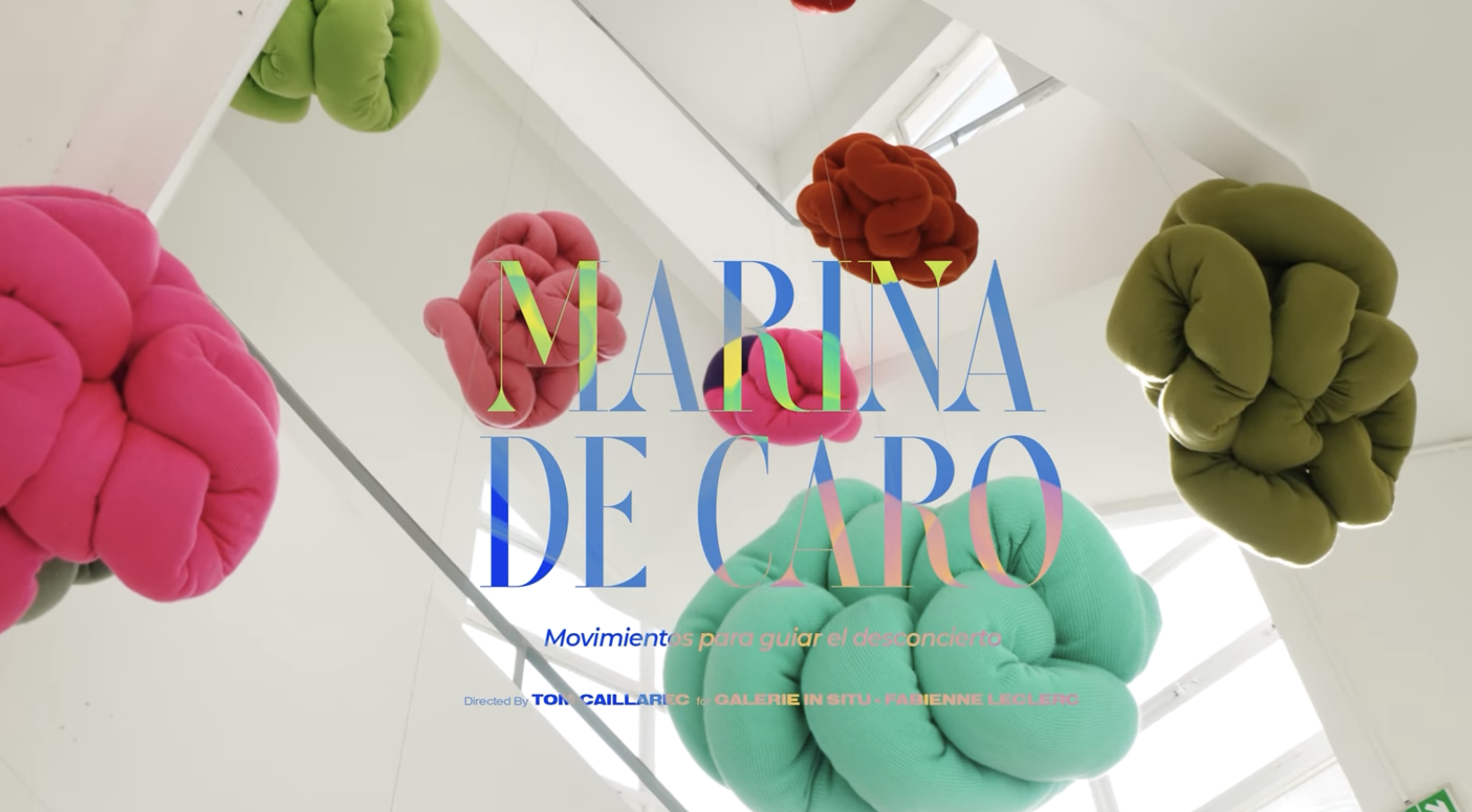De Caro
Born in 1961, in Mar del Plata, Argentina. Lives and works in Buenos Aires.
"I think with my body, I draw with my body, my hands have eyes that spit out lines, shapes, threads and relationships; the images that come out of my hands make me. My body kneads the world. Marina De Caro is an Argentinian visual artist from Buenos Aires, one of the most influential Latin American artists of her generation. She inhabits the world as a painter, a draughtswoman, a dancer, a knitter, a teacher, a performer... She constantly reinvents space, amplifying it with unfamiliar gestures, liberating petrified geometries. She pushes back the limits of the expected to give existence to that which vibrates and invigorates, to that which surprises the norm, the habit, the conventional. To that which disconcerts.
Developing a multi-disciplinary body of work integrating drawing, sculpture and performance, Marina De Caro experiments with notions of space, bodily experience, intuition and emotion within a colorful universe. Her installations unfold in a sensitive, poetic space, often taking the form of flexible, mobile sculptures. Specially created to interact with the viewer-ice/interpreter, these works invite us to experience an unpredictable dimension of everyday life, behavior and bodily and social norms.
EXHIBITION (SELECTION)
SOLO & GROUP SHOWS (SELECTION)
2025
Avant la forme, j'écoute les plaintes, Galerie In Situ - fabienne leclerc, Grand Paris, FR
Una puntada para cada desvelo, Confort Moderne, Poitiers, FR
Corps insensés, FRAC Franche-Comté, Besançon, FR
2024
Conjurer l'horizon, Mac-Val, Musée Contemporain du Val-de-Marne, Vitry-sur-Seine, FR
2023
Movimientos para guiar el desconcierto, Galerie In Situ - fabienne leclerc, Grand Paris, FR
Marina De Caro, Chromotopie de la Désobéissance Esquisse d'un opéra épistolaire, FRAC Franche-Comté, Besançon, FR
2022
JAIMES, Friche la Belle de Mai, Marseille, FR
2021
Tierra de las emociones perdidas, Galería Ruth Benzacar, AR
2019
Arquitectura de un conjuro, Museo Caraffa, AR
2018
Negro que mueve el Universo, Museo de los Inmigrantes, AR
2017
El universo en un hilo, Ópera de cámara, TACEC Teatro Argentino de La Plata, AR
2015
El primer paso en la luna, Galería Ruth Benzacar, AR
Contra la gravedad, Museo de Arte Moderno de Buenos Aires, AR
Hasta alcanzar la calma, Galería Ruth Benzacar, AR
Paisajes de árboles turquesa, Múseo PROA, AR
2014
Ejercicios contra la melancolia, Centro Cultural Matucana 100, Santiago de Chile, CHL
2013
La magia contra el estado, Galería Ruth Benzacar, AR
2011
El mito de lo posible, Biennale de Lyon, Lyon, FR
Turista en un agujero negro, Galería Ruth Benzacar, AR
2010
Thinking utopías, Espace Culturel Louis Vuitton, Paris, FR
La marea estaba... nosotros también (projet à quatre mains avec Pablo Besse), Galería SAPO, Buenos Aires, AR
2009
La belleza es de los artistas cuando la felicidad es compartida. Belleza y Felicidad, Buenos Aires, AR
2008
Marina De Caro: Hormiga argentina N°6, Museo Provincial de Bellas Artes "Dr. Juan R. Vidal" Corrientes, AR
2007
4 ojos ó dependiendo de tu humor, Americas Society, New York, US
Los trabajos y los días contra horas-reloj, Galería Ruth Benzacar, AR
Desplazamientos, entre la escultura y la instalación, Bienal de Pontevedra, Centro Cultural Recoleta, ES
La última costura, Belleza y Felicidad, Buenos Aires, AR
2006
Entreparéntesis, Bienal de Pontevedra, Galicia, ES
Perro volador, Bellez y Felicidad, Villa Fiorito, Buenos Aires, AR
2001
En circulación, Espacio Vox Bahía Blanca, AR
2000
Dijubos, Centro Cultural Borges, Buenos Aires, AR
1998
Projeto Mural apresenta Marina De Caro, Escaço Unibanco Belas Artes Belo Horizonte, BR
Tricot, Insituto de Cooperación Iberoamericana, Buenos Aires, AR
AWARDS
2022
Prix Pebeo, ART-O-RAMA, Marseilles, FR
2021
Prix 8M, Incorporación de obras al Patrimonio Nacional, AR
2012
Prix Konex de Platine: Arte Textil. Prix Konex 2012: Artes Visuales. Diploma al Mérito: Arte Textil. Fundación Konex, Buenos Aires, AR
2011
Sélectionnée. GICBiennale International Competition, 6th Gyeonggi International Ceramic, Biennale Gyeonggi-do, KR
2010
3° Prix. Salón Nacional de Pintura 2010 Fundación Banco de la República Argentina Buenos Aires, AR
2002
Diploma al Mérito: Arte Textil. Fundación Konex, Buenos Aires, AR
2000
Prix a la Creatividad Artística en Artes Visuales, Fondo Nacional de las Artes Buenos Aires, AR
1999
Prix Leonardo. Museo Nacional de Bellas Artes (MNBA) y Asociación Argentina de Críticos de Arte, Buenos Aires, AR
Premier Prix de Peinture. III Premio, Federico Jorge Klemm a las Artes Visuales, Fundación Federico Jorge Klemm, Buenos Aires, AR
1998
Prix des Arts Visuels. Premio Ignacio Pirovano al Artista Joven del Año, Asociación Argentina de Críticos de Arte, Buenos Aires, AR
1997
3° Prix de Peinture. 1° Prix Federico Jorge Klemm a las Artes Visuales. Fundación Federico Jorge Klemm, Buenos Aires, AR
1996
Ternada. Experiencias Año 1996. Premio a las Artes Visuales. Asociación Argentina de Críticos de Arte, Buenos Aires, AR
1991
Mención Indumentaria, 2e Bienal de Arte Joven Buenos Aires, AR
GRANTS & RESIDENCIES
2020
Residencia SOMA, Mexico City, MX
2012
Résidence et investigation sur l'anarchisme en France, FRAC Franche-Comté, Besançon, FR
2015
Shigaraki Ceramic Art Center, Shigaraki, JP
2010
Residencia Sundaymorning@ekwc, European Ceramic Work Center's-Hertogenbosch, NL
2007
RIAA Residence, Edition '07, Residencia Internactional Argentina de Artistats (RIAA), Ostende, AR
2000
Bourse Encuentro de Confrontación de Obra, Proyecto Trama, Buenos Aires, AR
1999
Subvention à la Création, Fundación Antorchas, Buenos Aires, AR
Bourse d'Arts Plastiques (Projet de création) (Art Conceptuel Bourse), Fondo Nacional de las Artes, Buenos Aires, AR
1997/01
Bourse Kuita, 3è édition, Centro Cultural Borges, Buenos Aires, AR
BIBLIOGRAPHY
ABOUT SOLO SHOWS
GUGNON, Annabelle; entretien avec GALBERT de, Albertine; Galerie In Situ - fabienne leclerc, cat. expo. "Marina De Caro: Movimientos para guiar el desconcierto", In Situ - fabienne leclerc, 10 septembre au 21 octobre 2023, Romainville.
NOORTHOORN de, Victoria (curadora); VILLA, Javier (curador), "Marina De Caro: Contra la gravedad". éd. Ruben Mira, (cat. exp., Buenos Aires, Museo de arte de Moderne de Buenos Aires, 2015), Buenos Aires, Museo de Arte Moderno de Buenos Aires, 2015.
ANDREINI, Vanna: “Sin título” (Untitled), en Turista en un agujero negro (Tourist in a Black Hole). Buenos Aires: Ruth Benzacar Galería de Arte, 2011 (Catálogo).
LESCANO, Victoria: “Colección: Los trabajos y los días contra horas reloj” (Collection: work and days against the hours of the clock), en Los trabajos y los días contra horas reloj (Work and Days Against the Hours of the Clock). Buenos Aires: Ruth Benzacar Galería de Arte, 2007 (Catálogo).
NOORTHOORN de, Victoria (curadora): El círculo caminaba tranquilo: La Colección Deutsche Bank en diálogo con obras del Museo de Arte Moderno de Buenos Aires (The Circle Walked Casually: the Deutsche Bank Collection in dialogue with works from the Museo de Arte Moderno de Buenos Aires). Buenos Aires: Ministerio de Cultura del Gobierno de la Ciudad Autónoma de Buenos Aires. Museo de Arte Moderno de Buenos Aires, 2014 (Catálogo).
CIPPOLINI, Rafael (et al.): Algunos artistas/Arte Argentino 1990-hoy (Some Artists/Argentine Art 1990-today). Buenos Aires: Fundación Proa, 2013 (Catálogo).SPIVAK, Laura: Pasa tiempo (Pass Time). Buenos Aires: Fundación Federico Jorge Klemm,
2013 (Catálogo).
NOORTHORN, Victoria: De Rosas, Capullos y otras fábulas. (On Roses, Hoods and Other Tales) Buenos Aires: Fundación Proa, 2005.
FERRANDO, Guillermo (edit.): Catálogo 5ª Bienal Internacional de Arte Textil, Palais de Glace, 1 al 26 de abril de 2005 (5th Catalogue International Biennial of Textile Art, Palais de Glace, 1-26 April, 2005). Buenos Aires: World Textile Art, 2005 (Catálogo).
FORCINITI, Federico: “Poemas IV y V” (Poems IV and V), en Tragedia griega (Greek Tragedy). Buenos Aires: Alberto Sendrós Galería de Arte, 2005 (Hoja de sala).
PALACIOS, Pablo: “Poemas I, II y III” (Poems I, II and III), en Tragedia griega (Greek Tragedy). Buenos Aires: Alberto Sendrós Galería de Arte,
2005 (Hoja de sala).
NOORTHOORN, Victoria: “Marina De Caro”, en Aguas de marzo (Waters of March). Buenos Aires: Alberto Sendrós Galería de Arte, 2003 (Hoja de sala).
DE CARO, Marina: “El valor de las cosas” (The Value of Things), en El valor de las cosas (The Value of Things). Buenos Aires: Espacio Lelé de Troya en ArteBA, 2002 (Hoja de sala).AA.VV.: Estudio Abierto Retiro (Open Studio Retiro). Buenos Aires: Gobierno de la Ciudad de Buenos Aires, 2003 (Catálogo).
HERRERA, María José: “Marina De Caro: Domingo X027”, en Domingo X027. Buenos Aires: Gara Galería de Arte, 2001 (Hoja de sala).
AISENBERG, Diana: “Marina De Caro en el Borges”, en Dibujos (Drawings). Buenos Aires: Centro Cultural Borges, 2000 (Catálogo).
FRANZETTI, Silvana: “Binarios, lenguaje secreto” (Binaries, a secret language), en Jornadas de Arte Argentino del Siglo XX (Events in Argentine Art in the 20th Century). Buenos Aires: Fundación Banco Patricios, 1996 (Hoja de sala).
AA.VV.: Estudio Abierto San Telmo/Montserrat (Open Studio San Telmo/Monserrat). Buenos Aires: Gobierno de la Ciudad de Buenos Aires,
2002 (Catálogo).
BUCCELLATO, Laura (ed.): Últimas tendencias en la colección del Mamba – donaciones (Latest Trends in the Malba Collection – donations). Buenos Aires: Museo de Arte Moderno de Buenos Aires, 2002 (Catálogo).
BUCCELLATO, Laura and ALONSO, Rodrigo (curators): Arte de Acción 1960-1990 (Action Art 1960-1990). Buenos Aires: Museo de Arte Moderno de Buenos Aires,1999 (Catálogo).
BONINO, Alberto and PRIETO, Susana (catalogue design): Premios Fortabat ’99 en Museo Nacional de Bellas Artes, Museo Nacional de Bellas Artes (Fortabat Prizes ’99 at the Museo Nacional de Bellas Artes). Buenos Aires: Fundación Amalia Lacroze de Fortabat, 1999 (Catálogo).
ABOUT GROUP SHOWS
“Ramona no tiene traducción, habla en castellano” (Ramona has no translation, she speaks in castellano), Ramona, Nº 101, 2010, pp. 29-30.
“Desde la propia casa hasta las redes profesionales” (From one’s own home to professional networks), Ramona Nº 69, 2007, pp. 71 -74.
“Una nueva percepción del espacio reclama una sensibilidad diferente” (A new perception of space calls for a different sensibility), Ramona, Nº 50, 2006, p. 33.
ARAUJO, Mercedes and DE CARO, Marina: “¿Cuánto vale una obra de arte?” (How much is a work of art worth?), Ramona, Nº 25, 2002, pp. 76-78.
“La Vox, Blanco, Valli… Bahía Blanca no descansa” (The Vox, Blanco, Valli... Bahia Blanca never sleeps), Ramona, Nº 23, 2002, p. 66.
“S/T”, in Diana Aisenberg. Sobremesa. Bahía Blanca: Espacio Vox, 2002 (Hoja de sala).
CANCELA, Delia and DE CARO, Marina: “Acerca de pérdidas y recuperaciones permanentes” (On permanent losses and recoveries), Ramona, Nº 13, 2001, pp. 32-33.
BOOKS
BELTRÁN, Erick: The Circle Walked Casually. Berlín: Deutsche Bank AG, 2013.
DAVIS, Fernando; LONGONI, Ana: Doscientos años de pintura argentina. En los márgenes de la pintura: de 1960 a comienzosdel siglo XXI (Two Hundred Years of Argentine Painting. On the Margins of Painting: from 1960 to the Beginningsof the 21st century). Buenos Aires: Banco Hipotecario, 2013.
DEL RIO, Claudia (et al.): Pieza Pizarrón, 2006-2012 (Blackboard Piece 2006-2012). Rosario: Club del Dibujo, 2013.
OLIVERA, Elena (ed.): Estéticas de lo extremo (Aesthetics of the Extreme). Buenos Aires: Emecé arte, Grupo Editorial Planeta, 2013.
HUG, Alfonso; GUEVARA, Paz (concepto y coord. editorial): 1ª Bienal de Montevideo – El Gran Sur(1st Montevideo Biennial – The Great, 2012.
South). Montevideo: Fundación Bienalde Montevideo, 2012.2011.
ARDENNE, Paul (et al.): Espace culturel Louis Vuitton. Landscapes of Contemporary Creation.Arles: Actes Sud, 2011.
CHEVALIER, Joanna; MIKAELOFF, Hervé;DE GONET, Juliett: Qui es-tu Peter?.París: Louis Vuitton Malletier, 2011.
BUCCELLATO, Laura (et al.): Museo de Arte Moderno de Buenos Aires: Patrimonio.Buenos Aires: Asociación Amigos del Museo de Arte Moderno, 2011.
De CARO, Marina (et al.): Manuscrito: Marina De Caro. Buenos Aires: Patricia Rizzo Editora, 2011.
CIPPOLINI, Rafael; FARINA, Fernando; LABAKÉ, Andrés (curadores): Poéticas Contemporáneas: Itinerarios en las artes visuales en la Argentina de los 90 al 2010 (Contemporary Poetics: Itineraries in the Visual Arts in Argentina from the 90s to 2010), Buenos Aires: Fondo Nacional de las Artes, 2010.
NAVARRO, María (et al.): Claves actuales del pensamiento (Key Aspects
of Contemporary Thought). Madrid: Plaza y Valdéz Editores, 2010.
JOZAMI, Marlise (coord.); ESPATH PEDROSO, Franklin y ROSENBERG, Adriana (curadores): Argentina Hoy (Argentina Today). Río de Janeiro y San Pablo: Banco do Brasil, 2009.
PACHECO, Marcelo; KATZENSTEIN, Inés; GARCÍA NAVARRO, Santiago: Arte contemporáneo, donaciones y adquisiciones Malba – Fundación Costantini
(Contemporary Art, Donations and Acquisitions Malba – Fundación Costantini). Buenos Aires: Fundación Eduardo Costantini, 2007.
LÓPEZ ANAYA, Jorge: Arte Argentino –Cuatro siglos de historia (1600-2000) (Argentine Art – Four Centuries of History 1600-2000). Buenos Aires:Emecé Editores, 2005.
PATANIA, Micaela (coord.): Premio Banco de la Nación Argentina a las Artes Visuales 2000 (Banco de la Nación Argentina Prize for the Visual Arts), Buenos Aires: Fundación Banco de la Nación Argentina, 2001.
GUMIER MAYER, Jorge; PACHECO, Marcelo (curadores): Artistas Argentinos de los ’90 (Argentine Artists of the 90s). Buenos Aires: Fondo Nacional de las Artes, 1999.
PRESS ARTICLES, INTERVIEWS & REPORTS IN THE MEDIA AND ACADEMIC PUBLICATIONS
2014
DE ARTEAGA, Alicia: “Blanco sobre blanco” (White on White), La Nación, Buenos Aires, 25 de julio de 2008(suplemento adn Cultura).
FEINSILBER, Laura: “Imperdibles imágenes de artistas de diverso origen” (Unforgettable images by artists from different origins), Ámbito financiero,
Buenos Aires, 8 de julio de 2014.
PEREZ BERGLIAFFA, Mercedes: “El bello vuelo de la línea sobre el espacio” (The Beautiful Flight of the Line Over Space), Revista Ñ, Buenos Aires, 26 de julio de 2014.
NOËL, María: “De la mano de Felisberto” (By Felisberto), Criterio, Buenos Aires, octubre de 2014.
2013
SÁNCHEZ, Julio: “Marina De Caro: Creo que voy a seguir siendo artista” (Marina De Caro: I think I’m going to go on being an artist), El gran otro, Nº
2, Buenos Aires, 2013.
S/F: “El Laberinto de los sentidos.
Nuevas manera de acercarse a un museo” (The Labyrinth of the Senses. New ways of approaching a museum), MiráBAN, Nº 62, Buenos Aires,
noviembre de 2013.
2012
BATTISTOZZI, Ana María: “Una belleza sin razón” (A Nonsensical Beauty), Revista Ñ, Buenos Aires, 4 de abril de 2012.
S/F: “Art for a Cause, Conexión Colombia Auction”, ArtNexus, Bogotá. (En línea: www.artnexus.com/PressReleases_View.aspx?DocumentID=24637)
2011
AMIGO, Roberto: “Veintiuna reflexiones inconclusas ante la obra de Marina De Caro” (Twenty-One Inconclusive Reflections on the Work of Marina De Caro), en Manuscrito: Marina De Caro. Buenos Aires: Patricia Rizzo Editora, 2011.
AZUIRY, Philippe: “Terrible, Biennale de Lyon”, Libération, París, 15 de septiembre de 2011.
DAGEN, Philippe: “Lyon plus intense que Venise” (Lyon more Intense Than Venice), Le Monde, París, 15 de septiembre de 2011 (Suplemento XIeBiennale de Lyon).
SAAVEDRA, Viviana: “Marina de Caro y Martin Weber muestras paralelas en Ruth Benzacar” (Marina de Caro and Martin Weber, parallel shows at the
Ruth Benzacar), Arte Online, Buenos Aires, 29 de agosto de 2011.
2010
REBOLLO GONÇALVES, Lisbeth: “7th Mercosur Biennial - Under the leadership of artists”, ArtNexus, N° 76, Bogotá, marzo-mayo de 2010. S/F: “57 art folio remix”, Remix, Nº 161, Buenos Aires, junio de 2010.
2009
GALLARDO, Ana: “Un mar de lágrimas” (A Sea of Tears), Página/12, Buenos Aires, 8 de marzo de 2009 (suplemento Radar).
IGLESIAS, Claudio: “Emprendimientos personales y políticas públicas: sobre la Bienal del Mercosur” (Personal Enterprises and Public Policies: on the
Mercosur Biennial), A*Magazine, Nº 50,
Barcelona, 24 de noviembre de 2009.
URQUIZA, Mercedes: “La pasión del coleccionista” (A Collector’s Passion), Perfil, Buenos Aires, 15 de febrero de 2009 (suplemento Cultura).
2008
LESCANO, Victoria: “En Kenzo, y con delantal propio” (At Kenzo with Your Own Apron), Página/12, Buenos Aires, 27 de junio de 2008 (suplemento Las/12).
MELTZER, Eve: “Beginning with a Bang”, Frieze Magazine, Nº 113, Londres, 2008.
VERLICHACK, Victoria: “Hogar, dulce hogar” (Home Sweet Home), La Nación, Buenos Aires, 14 de junio de 2008 (suplemento ADN Cultura).
S/F: “Qui a peur du noir?” (Who’s Afraid of the Dark ?), BeauxArts Magazine, París, junio de 2008).
2007
DE ARTEGA, Alicia: “Un viaje de ida y vuelta” (A Return Trip), La Nación, Buenos Aires, 11 de marzo de 2007 (suplemento Cultura).
LESCANO, Victoria: “Los trabajos silenciosos” (Silent Works), Página/12,
Buenos Aires, 17 de agosto de 2007 (suplemento Las/12).
LÓPEZ ANAYA, Jorge: “Peripecias de la metáfora” (The Vicissitudes of Metaphor), La Nación, Buenos Aires, 25 de agosto de 2007 (suplemento ADN
Cultura). S/F: “Proa sala de prensa” (Proa Press Room), Arte al Día, Buenos Aires, mayo de 2007 (suplemento ArteBA).298 299
Texts
Extract of a conversation between Marina de Caro and Albertine de Galbert (Paris, 2023)
ADG: How do you choose your colors?
MDC: It's not really a choice, I don't really care. It just needs to be organic. I don't like when it clashes too much with reality. The colors should be "attached" to one another. For example, for Hormiga argentina [Argentinian ant] - the pieces made with textile tubes and installed in the gallery's staircase -, pink helped me create a path. It is mostly the distribution of colors in space that aids the organic perception and reading of the work, so that the visitors can easily feel involved.
ADG: Are there colors you would never work with?
MDC: No, I've done the exercise of working with all colors, even the ones that I don't like.
ADG: What colors don't you like?
MDC: Purple.
ADG: Ah, you don't like it?
MDC: I hate purple, I despise this color, and yet I've just done a purple painting.
ADG: Do you know why?
MDC: I don't like it. I couldn't wear this color for example, I don't know why. I can't find any "purple gestures" in my body. But even if I don't like it, I work with it because it helps me step out of myself; otherwise, I'd always stay the same.
ADG: I'm talking about color because it's crucial in your work. You're even part of a collective you created with artists and art theorists3: Cromoactivismo. It's a movement aimed at restoring the symbolic and political significance of color (as opposed to Pantone, for example, which classifies and neutralizes the affective impact of color). Is that right?
MDC: Yes, but Cromoactivismo is very specific; it's not the same as working with color in works exhibited in institutions or galleries. In Cromoactivismo, we symbolically "load" a color with our individual or collective political experiences. We also draw from archives, which, for me, are alive. On the other hand, here, it's about building an experience, which then will become "chromo-active". Color doesn't have a symbolic value in itself; it requires the experience. In my opera, I work with this double "value" of color, as container and as expression of the experience. In that work, color is both a symbol, content, and experience.
